Framework is a unique brand in the laptop space. When you order from Framework, you're getting a fully repairable and modular device. It makes some of our favorite laptops and even Chromebooks because of how we can tailor them to our liking, allowing you to swap out components like the CPU, storage, and more as you see fit. Based on feedback from the community, Framework recently rebranded the classic Framework Laptop to the Framework Laptop 13. Though the product name has changed (because a bigger 16-inch model is coming soon, although we won't be talking about it here since we don't have many details yet), the ideals are the same.
Ronald.phillips
Shared posts
Framework Laptop 13: Price, release date, and everything you need to know
Resident Evil 2 Remake, RE3Remake & Resident Evil 7 no longer have Ray Tracing on PC
Yesterday, Capcom update the PC versions of Resident Evil 2 Remake, Resident Evil 3 Remake and Resident Evil 7. However, it appears that the Japanese team has messed things up, as these three games no longer support Ray Tracing on PC. From what we know so far, these patches were meant to remove DX11 from … Continue reading Resident Evil 2 Remake, RE3Remake & Resident Evil 7 no longer have Ray Tracing on PC →
The post Resident Evil 2 Remake, RE3Remake & Resident Evil 7 no longer have Ray Tracing on PC appeared first on DSOGaming.
Why is ‘Juice Jacking’ Suddenly Back in the News?

KrebsOnSecurity received a nice bump in traffic this week thanks to tweets from the Federal Bureau of Investigation (FBI) and the Federal Communications Commission (FCC) about “juice jacking,” a term first coined here in 2011 to describe a potential threat of data theft when one plugs their mobile device into a public charging kiosk. It remains unclear what may have prompted the alerts, but the good news is that there are some fairly basic things you can do to avoid having to worry about juice jacking.
On April 6, 2023, the FBI’s Denver office issued a warning about juice jacking in a tweet.
“Avoid using free charging stations in airports, hotels or shopping centers,” the FBI’s Denver office warned. “Bad actors have figured out ways to use public USB ports to introduce malware and monitoring software onto devices. Carry your own charger and USB cord and use an electrical outlet instead.”
Five days later, the Federal Communications Commission (FCC) issued a similar warning. “Think twice before using public charging stations,” the FCC tweeted. “Hackers could be waiting to gain access to your personal information by installing malware and monitoring software to your devices. This scam is referred to as juice jacking.”
The FCC tweet also provided a link to the agency’s awareness page on juice jacking, which was originally published in advance of the Thanksgiving Holiday in 2019 but was updated in 2021 and then again shortly after the FBI’s tweet was picked up by the news media. The alerts were so broadly and breathlessly covered in the press that a mention of juice jacking even made it into this week’s Late Late Show with James Corden.
The term juice jacking crept into the collective paranoia of gadget geeks in the summer of 2011, thanks to the headline for a story here about researchers at the DEFCON hacker convention in Vegas who’d set up a mobile charging station designed to educate the unwary to the reality that many mobile devices connected to a computer would sync their data by default.
Since then, Apple, Google and other mobile device makers have changed the way their hardware and software works so that their devices no longer automatically sync data when one plugs them into a computer with a USB charging cable. Instead, users are presented with a prompt asking if they wish to trust a connected computer before any data transfer can take place.
On the other hand, the technology needed to conduct a sneaky juice jacking attack has become far more miniaturized, accessible and cheap. And there are now several products anyone can buy that are custom-built to enable juice jacking attacks.
Probably the best known example is the OMG cable, a $180 hacking device made for professional penetration testers that looks more or less like an Apple or generic USB charging cable. But inside the OMG cable is a tiny memory chip and a Wi-Fi transmitter that creates a Wi-Fi hotspot, to which the attacker can remotely connect using a smartphone app and run commands on the device.

The $180 “OMG cable.” Image: hak5.org.
Brian Markus is co-founder of Aries Security, and one of the researchers who originally showcased the threat from juice jacking at the 2011 DEFCON. Markus said he isn’t aware of any public accounts of juice jacking kiosks being found in the wild, and said he’s unsure what prompted the recent FBI alert.
But Markus said juice jacking is still a risk because it is far easier and cheaper these days for would-be attackers to source and build the necessary equipment.
“Since then, the technology and components have become much smaller and very easy to build, which puts this in the hands of less sophisticated threat actors,” Markus said. “Also, you can now buy all this stuff over the counter. I think the risk is possibly higher now than it was a decade ago, because a much larger population of people can now pull this off easily.”
How seriously should we take the recent FBI warning? An investigation by the myth-busting site Snopes suggests the FBI tweet was just a public service announcement based on a dated advisory. Snopes reached out to both the FBI and the FCC to request data about how widespread the threat of juice jacking is in 2023.
“The FBI replied that its tweet was a ‘standard PSA-type post’ that stemmed from the FCC warning,” Snopes reported. “An FCC spokesperson told Snopes that the commission wanted to make sure that their advisory on “juice-jacking,” first issued in 2019 and later updated in 2021, was up-to-date so as to ensure ‘the consumers have the most up-to-date information.’ The official, who requested anonymity, added that they had not seen any rise in instances of consumer complaints about juice-jacking.”
What can you do to avoid juice jacking? Bring your own gear. A general rule of thumb in security is that if an adversary has physical access to your device, you can no longer trust the security or integrity of that device. This also goes for things that plug into your devices.
Juice jacking isn’t possible if a device is charged via a trusted AC adapter, battery backup device, or through a USB cable with only power wires and no data wires present. If you lack these things in a bind and still need to use a public charging kiosk or random computer, at least power your device off before plugging it in.
28 State AGs Urge Congress To Pass Stalled 'Right To Repair' Bills
Read more of this story at Slashdot.
Renfield's Black & White Dracula Prologue Was Much Harder To Pull Off Than It Seems
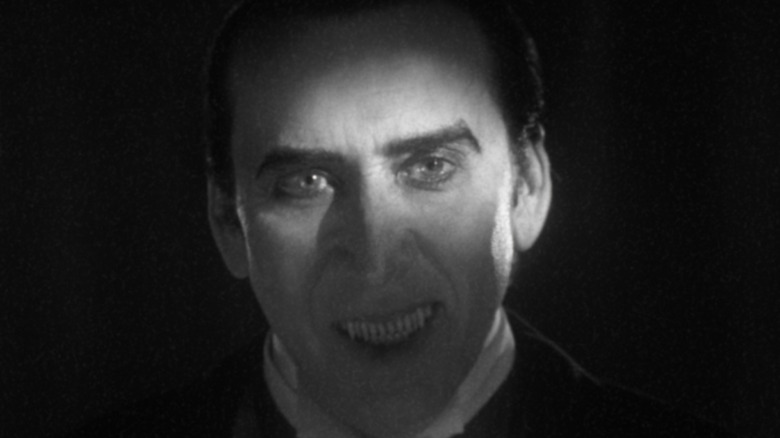
Inevitable comparisons are going be made between Bela Lugosi's classic Universal monster in Tod Browning's 1931 "Dracula" and Nicolas Cage's homage to the character in the new action comedy "Renfield," especially when director Chris McKay refers to the film as a "quasi-sequel" to the original. McKay's version certainly takes liberties with the material, catching up with Renfield (Nicholas Hoult) 90 years after Browning's masterpiece. Renfield realizes he's been in an extremely lengthy toxic relationship with his master while he sits in on group therapy sessions looking for potential victims. The abuse that Renfield suffers dates all the way back to their original meeting, prompting McKay and writers Robert Kirkman and Ryan Ridley to return to the scene of the crime in the opening prologue for "Renfield."
McKay and his team came up with the idea to essentially replace Lugosi and the original actor to play Renfield, Dwight Frye, with Cage and Hoult and insert them both into the original 1931 footage. The decision to recreate some of the more memorable moments in "Dracula" works to introduce audiences to Renfield's dysfunctional connection to Dracula and to pay tribute to the legacy that's come before. Due to limits in time and budgetary constraints, the prologue proved to be a much more difficult task than McKay and his collaborators expected. Originally, "Renfield" was also going to incorporate footage from other Hammer classics of the era and Frank Langella's indelible 1979 performance as the Count, which Cage also took inspiration from. When all of this proved too complicated, the decision was made to focus on Browning's version alone, and the entire crew went above and beyond to ensure that the sequence looked as authentic as possible.
An Incredible Attention To Detail
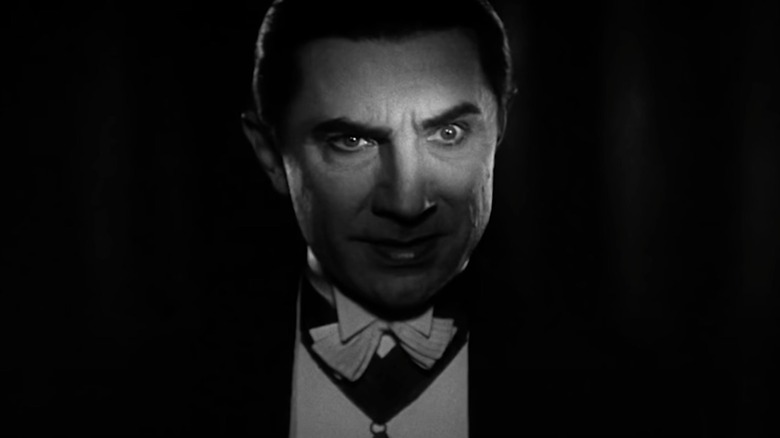
Recreating and matching footage that's over 90 years old proved to be incredibly difficult due to a lack of specific information about the logistics and equipment that was implemented and used on set when Lugosi and Frye filmed the original. McKay heavily relied on second unit director and visual effects supervisor James E. Price to do the homework that would help them line up the camera positions, lighting, and the original camera lenses used back then and duplicate it in the present day. "I searched high and low to find out as much as I could about what kinds of lenses and film stocks they used back then," Price explained to IndieWire. He continued:
"There's not a lot of information available, but we were able to estimate knowing the heights of the actors and the approximate size of props and furniture in the room. From that, we could reverse engineer what the focal length of the shot might have been."
Figuring out the exact height of Lugosi and Frye before shooting already shows the dedication the "Renfield" had to get the prologue right. Interestingly, Lugosi (6'1") is listed as only being an inch taller than Cage (6'0"), whereas Hoult (6'3") is quite a notch taller than Frye (5'7") was at the time. After reverse engineering the shots from "Dracula," Price and McKay selected the iconic images they wanted and imported them into the computer to be able to precisely duplicate the camera movements over multiple takes.
In the spirit of preservation, Universal created a new 4k master of Browning's original "Dracula" that, presumably, would have helped Price and McKay in their endeavor, but the better image quality just ended up highlighting the differences in each shot, a consistency problem that was common in the early days of filmmaking.
Being Faithful To The Source
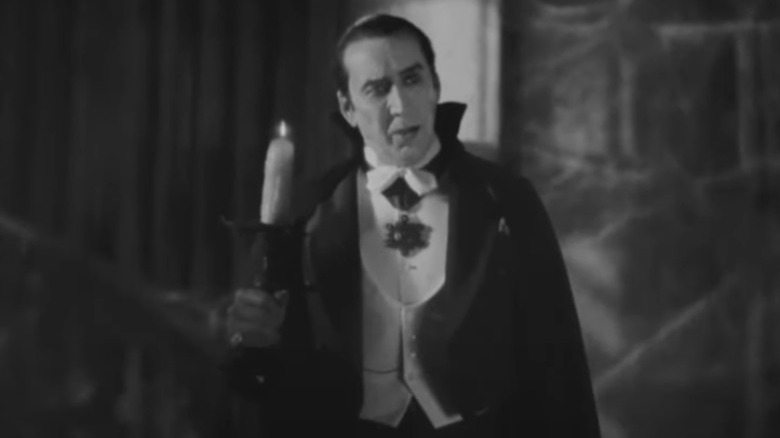
Looking at "Dracula" today, the overall look adds to the atmosphere. For Price, the constant changes in contrast and grain just created another challenge. As told to Indiewire:
"The amount of softness or sharpness changed from shot to shot, so we had a question to answer. Do we match every shot faithfully or to try to make it feel like more of a whole? In the end, we did a little bit of both. If it was a run of shots that were meant to be together, we made the grain and contrast consistent, if they were different scenes, we just let them be."
In the midst of a modern, big-budget production, it's a bold decision to commit to a black-and-white introduction, and McKay also worked with colorist Dave Cole to get the right look they had been searching for. Together, they "de-noised" the footage of the 1931 "Dracula" to match the more muted images found in the original. "The old look is more silvery and unique, and the backgrounds go out of focus really fast with the old lenses and the way the film stocks worked," explained McKay.
Originally, a Mitchell NC Standard 35mm Camera was used to shoot "Dracula." For another added bit of film history trivia, the actual #257 camera was also used on "Frankenstein," "Pinocchio," and "Fantasia." For Price, recreating what a nearly century-old piece of machinery captured took a lot of tinkering with the modern cameras used today. "Lenses today capture so much extra detail," he said. "We did a lot of experiments backing off on the detail level to make sure the images matched a traditional Hollywood movie of that era."
Check out some of the prologue footage in this TV spot to see if all of their efforts were justified.
Read this next: 14 Horror Movie Flops That Became Cult Classics
The post Renfield's Black & White Dracula Prologue Was Much Harder to Pull Off Than It Seems appeared first on /Film.
One Of The Scariest Scenes In The Evil Dead Is A Nasty Finale
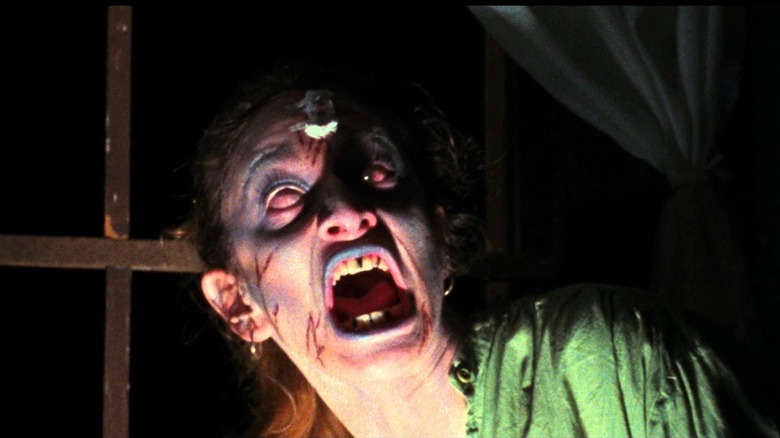
(Welcome to Scariest Scene Ever, a column dedicated to the most pulse-pounding moments in horror with your tour guides, horror experts Chris Evangelista and Matt Donato. In this edition, Matt returns to the original "The Evil Dead.")
In keeping with the "Evil Dead" theme in preparation for "Evil Dead Rise" on April 21, let's return to where it all began. Sam Raimi's "The Evil Dead" is an infamous video nasty that started one of horror's most beloved franchises. Between the original trilogy, Fede Álvarez's requel, and "Ash vs Evil Dead," there's something for everyone starting with a low-budget darling that held nothing back. It's grotesque, unbelievably scrappy, and inventive in the face of financial shortcomings. "The Evil Dead" is a miracle, so let's treat it like one.
"The Evil Dead" is Raimi's first and least comedic of the original trilogy. Practical effects can be more traumatizing than blending over-the-top humor and extravagant goriness. Some might scoff at that statement knowing how Deadite disintegration looks like Play-Doh or claymation, but we'll get there. What's scary is less straightforward horror and more how the artistic choices that seem very backyard DIY end up being more gnarly despite being "lesser" in some eyes. It's not "Evil Dead" (2013), but there's one glimpse that's even grosser and more disturbing in "The Evil Dead" using presumably household items.
The Setup
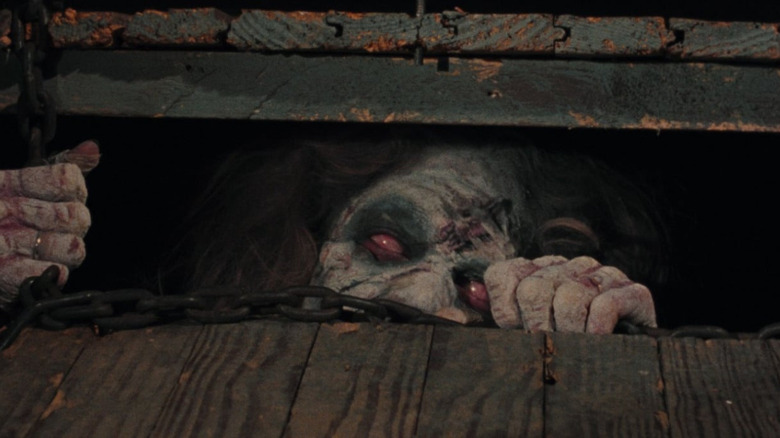
"The Evil Dead" sets up one of the most textbook definitions of "cabin in the woods" horror. Five Michigan State students, including Ash Williams (Bruce Campbell), head into the Tennessee wilderness where a cabin awaits. Upon arrival, the group encounters supernaturally suspicious events that initially go unquestioned in the name of staying positive. Then they find the Naturom Demonto and archaeologist Raymond Knowby's tape recorder — the beginning of the end for most visitors.
The Story So Far
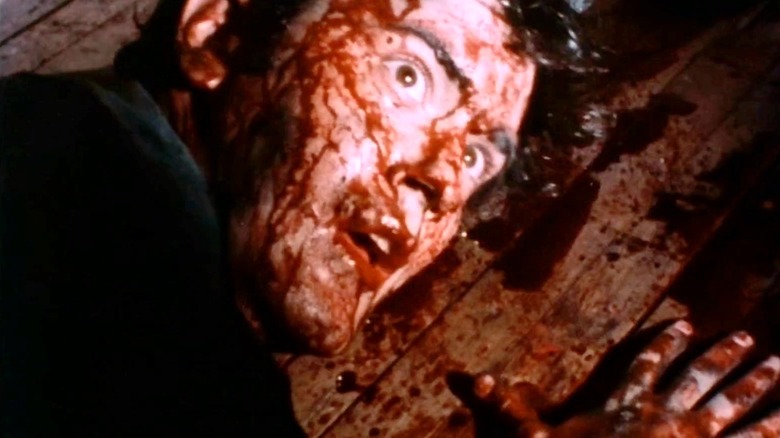
The story so far is one of blood, guts, and Deadite viciousness. Dunderhead Scott (Richard DeManincor) plays a tape of incantations that unleashes a demonic entity that preys upon Ash's group, starting with Cheryl (Ellen Sandweiss) in the woods (which we don't have to recount due to content). She becomes the entity's sleeper agent who enters the cabin, stabbing ankles with pencils and getting herself locked in the basement, but the damage is done. Ash is forced to battle, dismember, and dispose of friends who turn into Deadite beings until only Scott and Cheryl are left as Deadites — Ash's final confrontation.
The Scene
Ash is outnumbered by the Deadite versions of Scott and Cheryl, who grab, restrain, and beat him with metal pokers. His only hope is to throw the Naturom Demonto into a blazing fire, which freezes the Deadites in their tracks. Cheryl stops whacking Ash with her weapon, and Scott lies motionless. What happens next certainly helped "The Evil Dead" earn its video nasty designation.
Cheryl and Scott begin to decompose around Ash. Cheryl's hair falls out in clumps while Scott's face starts melting away like it's turning into soup. Other bodies start rotting at hyper speed, as lips disappear to reveal shifting teeth and bleeding gums or appendages start falling off. The Naturom Demonto starts suggestively waving its tongue while on fire, and Deadites mimic the same motion.Bodies litter the wooden cabin floor lookin' like skeletons wrapped in raw meat, and then an oatmeal-consistency puss starts oozing from wounds. Ash keeps looking around at the stomach-churning display, soaking it all in (yuck), and then, out of nowhere, demonic arms burst from Deadite corpses with even more gore splashed onto Ash. The chunky puss pours onto the floor, cranberry-saucy blood all over Ash, as the Deadites burst blood like geysers from necks or legs. We're stuck in this surreal splatterfest with Ash as bugs crawl over moldy gruel where bones and tissue used to be, in a repulsive display of Deadite deconstruction that is impossible to forget.
The Impact (Chris' Take)
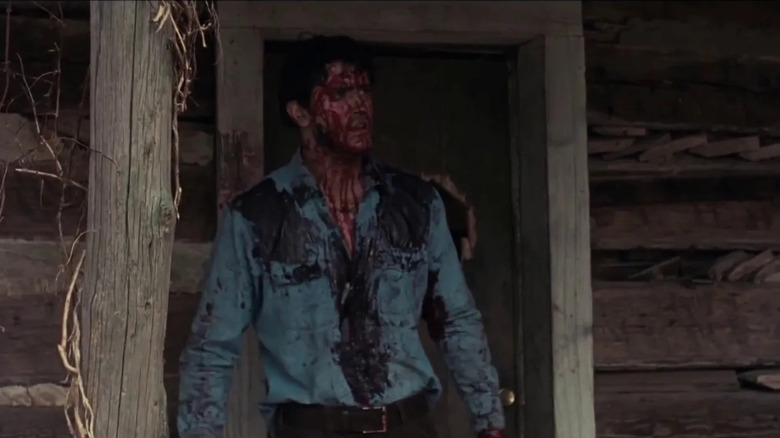
The "Evil Dead" franchise feels like it's primarily known for comedy, but I always like to remind folks that the original is going for more of a straight-up horror vibe. The DIY of it all only enhances the scares, making everything feel a little extra authentic, like we're watching some gruesome home movie. I particularly love this scene in question, in which the Deadites rot away with stop-motion and some fantastic sound design. The unreality of it all only adds to the scene, and as things grow more and more disgusting you can't help but marvel at it all. As Matt said above, this movie really is a kind of miracle. That it got made, distributed, and became a cult hit that spawned an entire franchise is somewhat amazing.
Read this next: The Saddest Character Deaths In Horror History
The post One Of The Scariest Scenes in The Evil Dead Is A Nasty Finale appeared first on /Film.
Patrick Stewart Was Told Star Trek: The Next Generation Wouldn't Even Last A Full Season
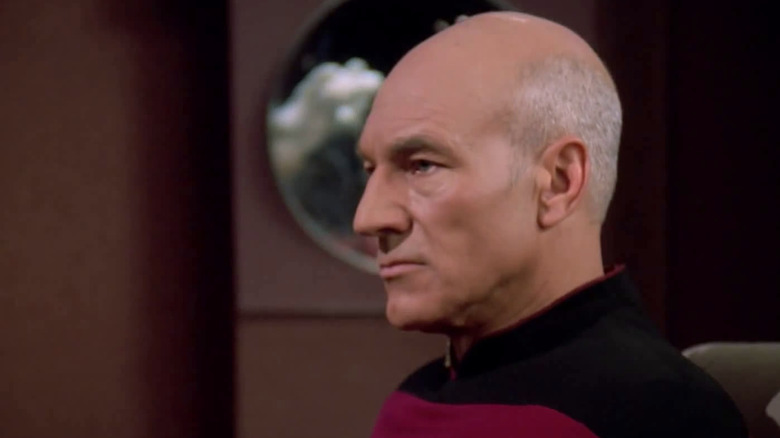
It's hard for many of us to imagine a world without "Star Trek: The Next Generation," but once upon a time, it was a risky sequel series potentially doomed to fail. Sir Patrick Stewart, who plays the steadfast Captain Jean-Luc Picard, didn't know much about "Star Trek" when he took the role in the late 1980s, and apparently he was told that the show would never make it past the first season. (Yikes!) Thankfully, those prognosticators were dead wrong, and "The Next Generation" ran for seven seasons and four films, ending with "Star Trek: Nemesis" in 2002. "The Next Generation" helped usher in the next era of "Star Trek," followed by shows like "Star Trek: Deep Space Nine" and "Star Trek: Voyager," which explored different parts of Starfleet and some very different kinds of missions. It wound up becoming the beginning of the greater "Star Trek" universe, but it was nevertheless a pretty risky proposition when the show first aired in 1987.
Some people didn't think that "Star Trek" could work without Kirk, Spock, Sulu, and the rest of the original Enterprise crew. What they didn't realize, however, is that "Trek" is a wonderfully wide universe to explore, with all kinds of stories to tell. As for Stewart, he didn't even really know much about the sci-fi series, as he was much more focused on his stage and film career. (He had, at least, starred in the wild sci-fi vampire film "Lifeforce" in 1985, so he wasn't entirely unfamiliar with sci-fi.) As such, when he got the call to try out for "Trek," he truly had no idea what was in store.
'I Once Or Twice Caught These Guys In Colored T-Shirts'
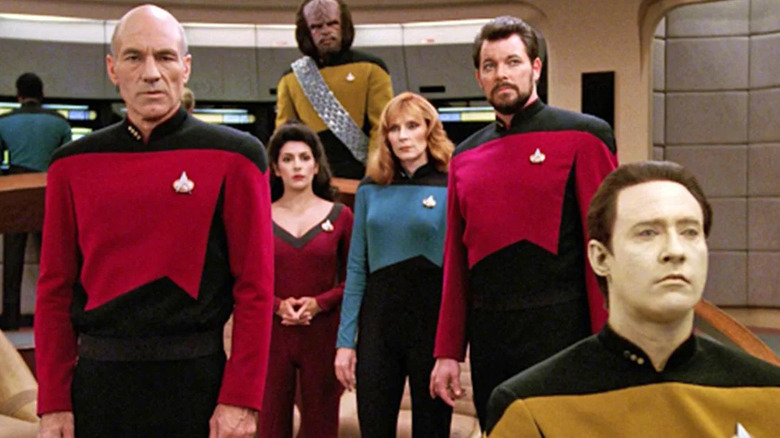
On an interview with CBS Mornings, the veteran of stage and screen was asked about his feelings back when he was going through the casting process for "Star Trek: The Next Generation." Patrick Stewart explained that while his children were apparently fans of the original series, watching it in syndication, he was told by other people that there was just no way another "Star Trek" could work:
"I called my children because I knew they watched something called 'Star'-something on Saturday afternoons, and I once or twice caught these guys in colored t-shirts. So I called them and said, 'Tell me, tell me! Because I've got a meeting today and I don't know what the meeting is about.' And I talked to a handful of people whom I knew and they all said, 'Look. You can't revive an iconic show like 'Star Trek.' You're probably not making it through the first season. So, you know, make a little bit of money for the first time in your life, maybe you meet some nice girls, you can get a suntan, go home.'"
Instead of just making a bit of primetime TV money and going about his merry way, Stewart would become one of the most famous faces of the franchise and would be forever entwined with Starfleet officer Jean-Luc Picard. "Star Trek" itself would also become a major part of his life going forward, as Stewart came to learn a whole lot about those "guys in colored t-shirts" -- far more than he ever possibly could have imagined.
The Future Of The Franchise

"Star Trek: The Next Generation" helped usher in the second wave of "Star Trek" shows and movies, leading to the series and films we have now. It's incredibly unlikely that any other "Trek" shows would have been created if "Next Gen" hadn't been successful, and that's kind of a sad world to imagine. "Star Trek" has become a huge part of pop culture and will continue long into the future with shows like "Star Trek: Lower Decks" and "Star Trek: Strange New Worlds." There's also a whole new Starfleet Academy series in the works, looking to the future of the Federation in a brand new way.
The full arc of "Star Trek: The Next Generation" is finally coming to a close with the finale of "Star Trek: Picard," which will wrap up Jean-Luc's life and legacy and hopefully provide closure for the rest of the crew of the Enterprise-D. Stewart may not have imagined that he would still be playing the Starfleet officer after 36 years, but it's impossible to imagine anyone else doing it better.
The series finale of "Star Trek: Picard" premieres Thursday, April 20, 2023, on Paramount+.
Read this next: 14 Underrated Star Trek: The Next Generation Episodes
The post Patrick Stewart Was Told Star Trek: The Next Generation Wouldn't Even Last a Full Season appeared first on /Film.
Elon Musk Just Made Twitter Irresistible To Content Creators, Even Those Who Hate His Guts

A compelling proposition. That’s how Twitter’s latest changes, announced by Elon Musk in his characteristically effusive tweets, could be described. The world’s richest person appears to be placing his bets on a scenario where some of the best content creators would continue to countenance his supposed toxicity in light of Twitter’s unmatched reach and appeal.
The Twitter Blue premium subscription tier is available for $8 per month or $84 per year. The subscription entails the coveted blue checkmark as well as access to a number of features, including the ability to edit tweets.
Apply to offer your followers subscriptions of any material, from longform text to hours long video!
Just tap on “Monetization” in settings.
— Elon Musk (@elonmusk) April 13, 2023
A couple of hours back, Elon Musk took to Twitter to announce that creators would soon be able to provide their subscribers and followers with a wide variety of content, ranging from long-form text to hours-long videos. These changes would place Twitter as the direct competitor of Google’s YouTube. This subscription option is available to all users who are above 18, have at least 500 followers, and have posted a minimum of 25 tweets within the last 30 days.
For the next 12 months, Twitter will keep none of the money.
You will receive whatever money we receive, so that’s 70% for subscriptions on iOS & Android (they charge 30%) and ~92% on web (could be better, depending on payment processor).
After first year, iOS & Android fees…
— Elon Musk (@elonmusk) April 13, 2023
Additionally, in what constitutes a coup de grâce, Elon Musk announced that Twitter would pass on the entirety of its earnings from subscriptions to content creators for a period of one year. This equates to 70 percent of the total subscriptions on iOS, given Apple’s cut of 30 percent, and around 92 percent of the subscription-based monetization derived from Twitter’s webpage (after subtracting the roughly 8 percent cut of the payment processors).
Finally, Twitter would actively promote such creators, who would be free to exit the platform with all of their content at any time.
These changes are apparently a direct challenge to Substack, which recently launched its Twitter-like Notes service. In a related controversy, Elon Musk unfollowed the Twitter account of Matt Taibbi – the journalist who published the so-called Twitter Files a few months back with much relish – last week when he indicated his preference to stick with Substack Notes going forward to protest the social media giant's decision to degrade its relationship with Substack.
Readers should note that Elon Musk had revealed during a Twitter Space meetup hosted by the BBC that almost all of the advertisers who had abandoned ship in the wake of the social media giant's change of ownership have now returned. Accordingly, Musk expects the global town square to become cash flow positive this quarter.
Of course, the last few days have been characterized by the controversy around the “government-funded media” label that Twitter has now pegged on the likes of NPR and BBC, prompting the former to cease all activity on the social media platform in protest.
I will pay a million Dogecoin for proof of this mine’s existence!
— Elon Musk (@elonmusk) April 12, 2023
In another weird controversy that erupted recently, Elon Musk announced a bounty of 1 million Dogecoins to any person who could prove that his family owned an emerald mine in South Africa. Of course, Musk’s own father has alluded to the mine in two interviews, one with Forbes, which has since then been removed and is only available as an archive, and the other with the New Yorker.
While Elon Musk’s penchant for delving headlong into fresh controversies continues to keep some content creators at bay, the lucrative monetization avenues that Twitter is now offering just might prove impossible to resist for a vast majority of this cohort, including those who ideologically hate all things Musk-related.
CISA Introduces Secure-by-design and Secure-by-default Development Principles
CISA has described and published a set of principles for the development of security-by-design and security-by-default cybersecurity products.
The post CISA Introduces Secure-by-design and Secure-by-default Development Principles appeared first on SecurityWeek.
FBI Arrests 21-Year-Old Guardsman in Leak of Classified Military Documents
A Massachusetts Air National Guard member was arrested Thursday in connection with the disclosure of highly classified military documents about the Ukraine war and other top national security issues.
The post FBI Arrests 21-Year-Old Guardsman in Leak of Classified Military Documents appeared first on SecurityWeek.
Nicholas Hoult Two Times
In Star Trek: Picard Season 3, Growing Older Is Awesome And Data Is Leading The Way
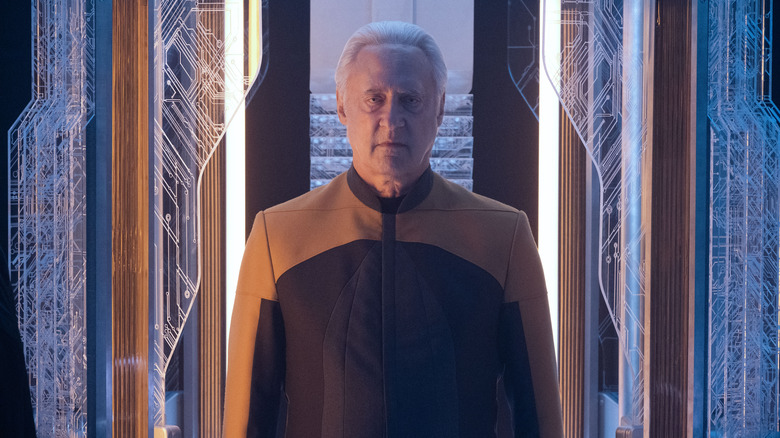
This article contains spoilers for season 3, episode 9 of "Star Trek: Picard."
In the "Star Trek: The Next Generation" episode "Inheritance" (November 22, 1993), the writers tossed in a quick, throw-away line of dialogue that explained away an ever-widening continuity problem of the show. In "Inheritance," the android Data (Brent Spiner) is introduced to a character name Julianna O'Donnell (Fionnula Flanagan), a long-lost wife of his creator, Dr. Noonien Soong. Effectively, Julianna is Data's mother. Later in the episode, when Julianna is injured, it's revealed that she, too, is an android, modeled after Soong's actual wife, who perished years before.
While examining the android Julianna, Geordi La Forge (LeVar Burton) explains how she operates and how her positronic brain was constructed. Dr. Crusher (Gates McFadden) notes that she gives off a false signal designed to throw off medical scans and trick doctors into thinking she's human. Geordi then also mentions that the signal is part of her program. "Not only does she age in appearance like Data, her vital signs change too." Nothing more is said of the issue.
Wait. Go back. "Age in appearance like Data?" Brilliant. This would explain how an android character like Data, made 100% of artificial parts, would age. An "aging program." After all, Data is played by the very human Spiner, and he came to look different over the seven years that elapsed between the beginning and end of the series. The mere mention of an "aging program" covers all the bases.
As of this writing, Spiner is 74, but has returned as a version of Data in the third season of "Star Trek: Picard." Thanks to another throw-away line of dialogue, however, Data's appearance as a 74-year-old man is not only explained but presented as a new superpower. Aging, it seems, is an exhilarating experience.
What A Gas It Is Getting Old
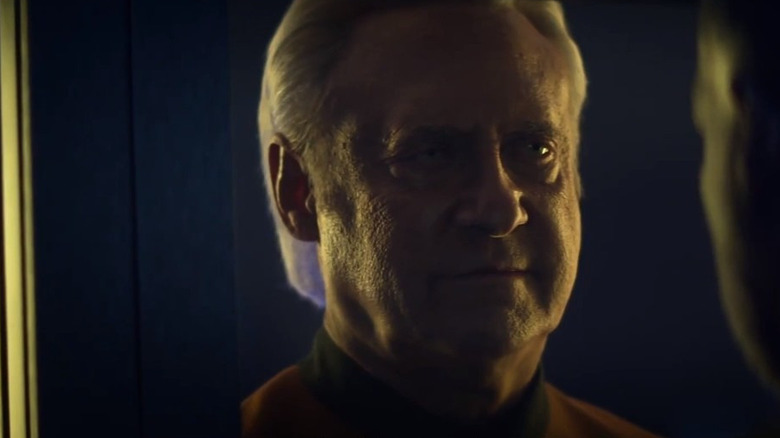
Data, of course, had returned in the first season of "Star Trek: Picard." A major plot thread involved a Federation scientist salvaging a single particle of Data's exploded body and somehow reconstituting his entire brain, complete with his memories, from it. Shortly after that, Data's memories were discovered on a computer hard drive, located on a distant androids-only planet. Picard (Patrick Stewart) also shunted his own consciousness into the hard drive, and he and Data were able to have face-to-face conversations inside. During those conversations, however, Brent Spiner's Data was digitally de-aged to look like he did back in 2002. He also plead for his own death, willing to finally experience mortality.
The man storing Data's consciousness, however, clearly didn't let it be deleted, and wasn't concerned with Data's pleas to die. Indeed, Altan Soong (also Spiner) eventually created a new android, with Data's consciousness completely restored. In the sixth episode of the third season of "Picard," it is explained that this new android not only contains Data's brain, but Lore's, Lal's, Dr. Noonien Soong's, and B-4's as well. This was to be a new composite being that possessed the emotions and experiences of multiple androids. The telling, throw-away line of dialogue? "This time, with the wisdom and true human aesthetic of age." With the totality of age, he says, a person may rise to be the best of us. If this new Data is going to be wise, then he'll need to look like an older man. Hence the grey hair and the wrinkles.
"Picard" is arguing, in that moment, that being old is preferable to being young. This is a fitting message for a returning cast whose youngest member is 68.
It's also refreshingly anti-ageist.
Old Age Is Necessary
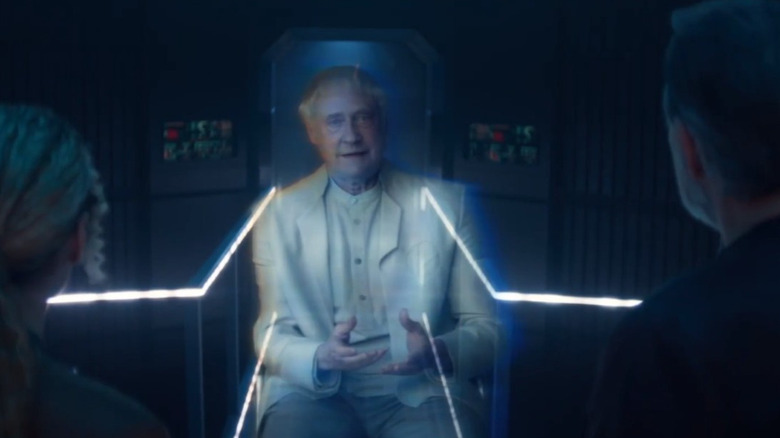
A few episodes later, when Data has been revived, he reveals that he does indeed possess memories and sensations that he had never experienced before. He cocks his head and his neck pops slightly. It clearly hurts, and the moment will be familiar to anyone who has experienced age-related neck problems. Rather than bemoan the experience, however, Data smiles, claiming that being old is going to be an interesting, exhilarating new adventure.
Indeed, being old was a plot point in the ninth episode of "Picard." Thanks to a complex series of events, Borg gene probes had infiltrated the brains of anyone who'd been using a transporter. It was explained, however, that the probes can only take hold in brains that are still developing. Since the human brain doesn't stop developing until around age 25, all of Starfleet's younger officers become infected. At the end of the episode, Starfleet was under attack from, essentially, every ensign in the fleet. In all honestly, it sounds more like a story from "Star Trek" Lower Decks."
However, since the "Next Generation" cast are all older than 25, they are left safe from the Borg infiltration, and are uniquely equipped to handle the Borg threat by mere dint of their age. It's not only exhilarating getting older. It's an advantage.
Additionally, the Borg baddies take advantage of Starfleet's high-tech ships to create a linked armada, joined by a shared consciousness. How does one approach such an armada without being assimilated as well? Why, just find an older ship. Something analog. Something that is, essentially, not connected to the internet. Something that the oldsters are familiar with.
Why not have the NextGen crew fly off in a restored Enterprise-D to save the day?
Grandpa Saves The Day
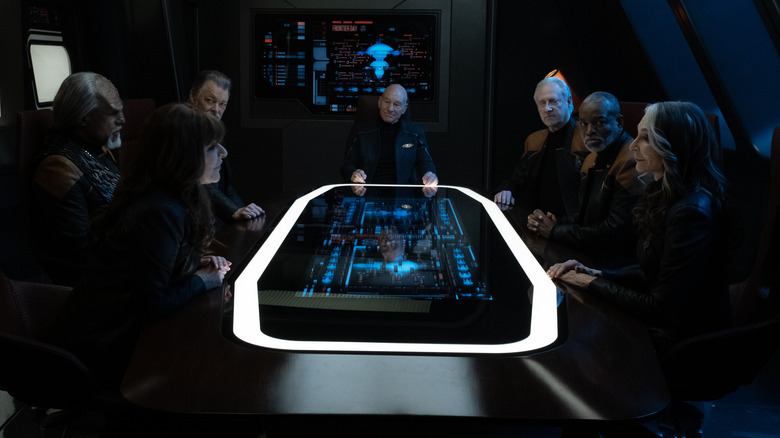
An older crew, an older ship, and familiar, decades-old technology will rescue us. Look out, whippersnappers. Your space grandparents are here to save the day.
While the nostalgia of these moments is painfully corny -- the reveal of the Enterprise-D will likely elicit as many groans as squeals -- the message of aging characters still being capable is actually appreciated. This isn't a matter of "old guys still got it," like in, say, the movie "Old Dogs" or "80 for Brady." This is an outward declaration that being old is better than being young. Despite the amount of nostalgia in the pop marketplace, genre heroes still tend to hover around age 25. Younger characters still have their lives to figure out, but are lithe and physically capable enough to be fighters and action heroes. As such, screenwriters tend to focus on that age group. "Picard" is saying that youths are the ones most susceptible to corruption, and it's only those with wisdom and experience that can save the day.
This philosophy is in keeping with the general attitude "Star Trek" seems to have about artifacts from the past. One can regularly see Starfleet crew members reading paper books and using antique musical instruments. Even in the 24th century, there will be room for the kind of technology you prefer, including the dated stuff. One can recreate entire environments on the holodeck, but there will still be time to read an actual James Joyce book.
Picard and co. are the books to read through. Oldsters as heroes. You love to see it.
The "Star Trek: Picard" series finale premieres Thursday, April 20, 2023, on Paramount+.
Read this next: Every Star Trek Series Ranked From Worst To Best
The post In Star Trek: Picard Season 3, Growing Older is Awesome and Data is Leading the Way appeared first on /Film.
In The War Between Exorcist Prequels, There Was A Clear Winner
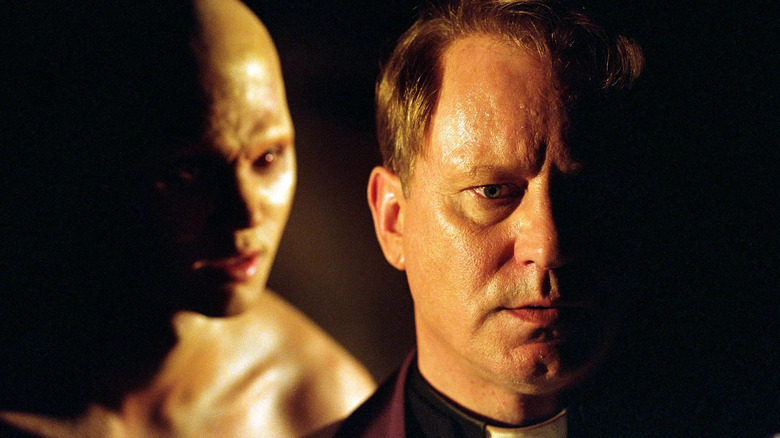
William Friedkin's "The Exorcist" is one of the best horror movies ever made, which makes it by extension one of the best movies ever made at all. But it's not just a powerful dramatic exploration of faith in an increasingly secular society, and it's not just a terrifically scary motion picture that stunned audiences; it was also a gigantic mega-blockbuster by any reasonable measure. If you adjust for inflation to determine how much "The Exorcist" would have made theatrically at today's ticket prices, you'll find it would have made over a billion dollars domestically, ranking it the ninth-highest-grossing movie in the history of the American box office. That's more than "Avengers: Endgame" or "Avatar."
So regardless of how excellent the original film was, "The Exorcist" was still a huge financial success, and we all know what happens to huge financial successes -- they get sequels. And "The Exorcist" had some very strange sequels. "Exorcist II: The Heretic" is one of the most baffling horror movies ever made, and time still hasn't unlocked all its gonzo, and frankly embarrassing mysteries. "The Exorcist III" wasn't very well-received at first, but now it's considered nearly as good as the original. As well it should be. It's brilliant.
The sequels may be weird journeys, but the saga of the prequel, "The Exorcist: The Beginning," and the other prequel, "Dominion: Prequel to the Exorcist," is a proper trip through Hollywood Hell. In the end, both films were critically disregarded, and both were financial duds. But only one of them now ranks among the best movies in the series. With David Gordon Green's new sequel trilogy on the horizon, it's time to dive back into the underexplored prequels.
The Trials Of Schrader And Harlin
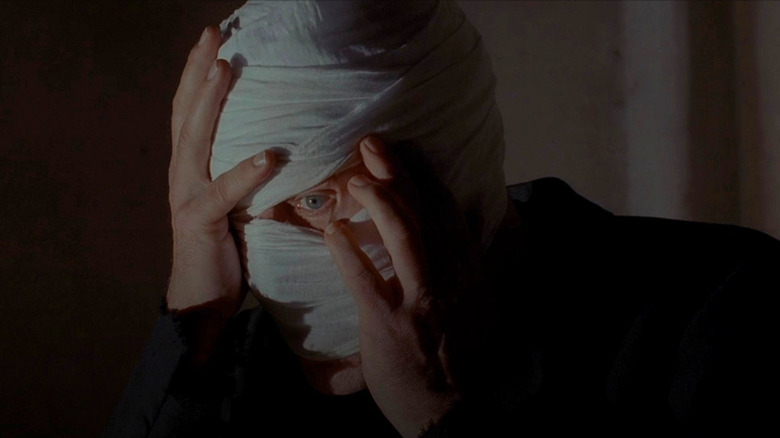
The horror genre was experiencing a resurgence at the turn of the 21st century, thanks in no small part to the success of "Scream," its copycats, and lucrative sequels to previously moribund franchises like "Bride of Chucky" and "Halloween H20." A return to one of the most successful and celebrated horror series in Hollywood history was inevitable, so Warner Bros. enlisted Paul Schrader, the writer of "Taxi Driver" and director of the recent Oscar-nominee "The Affliction" to direct a prequel about Father Merrin, played memorably by Max von Sydow in the original movie, performing his first exorcism.
Co-written by William Wisher Jr. ("Terminator 2") and celebrated novelist Caleb Carr ("The Alienist"), and starring Stellan Skarsgård as Father Merrin, Schrader's film went into and ultimately completed production, but was never finished. The studio thought early cuts of the movie weren't scary enough, so they eventually decided to scrap Schrader's version almost entirely, enlisting "Deep Blue Sea" and "Die Hard 2" director Renny Harlin to reshoot the majority of the footage from a screenplay rewritten by Harlin and Skip Woods ("Swordfish").
Harlin's version, "The Exorcist: The Beginning" was full of jump scares and gross-out moments, and grossed an underwhelming $78.1 million off a (now very much ballooned) budget of over $90 million. So nine months after Harlin's version got a critical drubbing, and with the story of Schrader's alternate cut now well known, the director was permitted to finish his version of the movie. But with only a short amount of time and just $35,000 to finish his film, which still needed special effects and a score, Schrader's "Dominion: Prequel to the Exorcist" also seemed potentially doomed. It was barely released. Critics didn't much like the new version either.
The Outclassed Exorcism
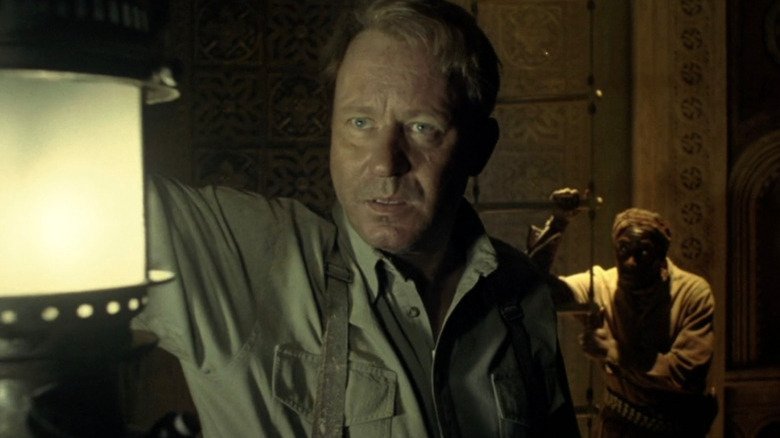
Renny Harlin's "The Exorcist: The Beginning" is very much the Saturday morning matinee version of the story both films tell. In this version, Skarsgård plays Merrin, a priest who left the church after a tragedy in World War II, who gets hired to infiltrate an archaeological dig in East Africa in the late 1940s. His mission is to bring back a talisman of Pazuzu, the demon from the original two "Exorcist" movies, whose visage would be well known to fans of the series.
Merrin finds the site to be an unholy church, allegedly built at the site where Lucifer fell to Earth. Meanwhile, he's tempted to romance by a local doctor, played by Izabella Scorupco ("Goldeneye"), and discovers that a local child whose brother was eaten by bloodthirsty hyenas — CGI creations that looked bad then and look a lot worse now — may be possessed by the devil. Meanwhile, tensions rise between a local tribe and the colonialist British military, probably due to demonic influence.
Harlin's film features gross-out pustules, easter eggs to the original movies, and a prologue featuring a massacre during the Crusades. It's the bigger, flashier, and sillier of the two, culminating in an unconvincing twist and a series of altercations between Merrin and a demon which are increasingly laughable. It ends with the devil running at Merrin for a couple of minutes while Merrin and a little kid scream holy scripture until the demon is like, "Oh right, never mind," and stops.
It's the "Exorcist" prequel where you can safely make out with your date in the back of the theater without feeling like you missed anything. That it's not the worst film in the series says a lot more about "Exorcist II: The Heretic" than it does about "The Beginning."
Possession Is Only 1/10th Of The Draw
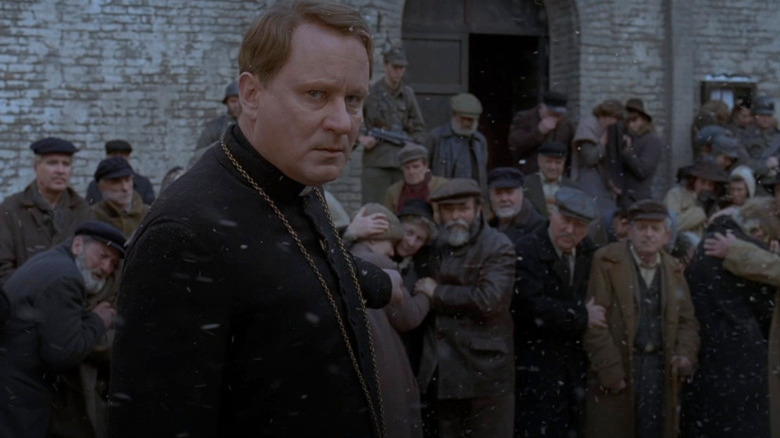
Paul Schrader's "Dominion: Prequel to the Exorcist" also has flaws, but a lot of them stem from post-production woes. The effects are still shoddy — although at least Schrader's rushed final version has an excuse — and yes, it's slow compared to its horror contemporaries. But in a world where indie powerhouse A24 has made serious dramas about wrestling with trauma that are only spiked by some horror elements into a popular horror genre all their own, "Dominion" feels surprisingly modern. Except for the lousy CG and inconsistent score.
Schrader's version doesn't find Merrin enlisted by a mysterious organization with a vague scheme regarding the demon from "The Exorcist." He's the archaeologist who discovered the unholy site in the first place, who hasn't left the church but is on sabbatical, wrestling with his faith because Nazis forced him to choose ten people to be senselessly murdered, in order to save everyone else in his town. He doesn't have a particularly romantic subplot with the doctor, just a shared understanding that both of them only survived World War II by making choices that scarred their souls.
"Dominion" isn't interested in fun. It's telling a story like the original "Exorcist," in which the influence of evil is insidious. If you turn your head to a slightly different angle, it wouldn't look like the work of the devil at all. The madness that besieges everyone looks an awful lot like the evils mankind perpetrated upon itself in World War II. Father Merrin responds to every moral question in "Dominion" with an educated response about human hypocrisy. He calls out the Vatican for its failings. He calls out the British for their colonialism. And when a grieving father asks if his murdered son is how God repays his faithful followers, Merrin hisses out an immediate, "Yes."
Insight In The Garden Of Good And Devil
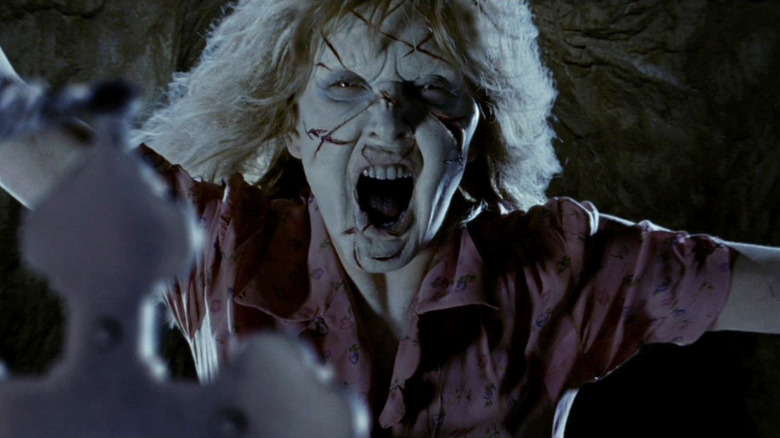
"The Exorcist: The Beginning" is about the triumph of good over evil. "Dominion: Prequel to the Exorcist" is about how goodness isn't triumphant. It's a much more complex perspective on human frailty, which suggests that the devil has genuine appeal even to the kind in spirit. He offers Merrin and the doctor the means to rewrite their own histories, to absolve themselves of their sins by reliving their lives and making different choices, proving that they were only ever abused pawns in an unfeeling god's design. But ironically, this gives Merrin strength. He learns that his actions, though themselves a tragedy, were the best he could do under horrible, unreasonable circumstances. He earns his own forgiveness.
Forgiving the moments where its post-production budget clearly failed it, "Dominion" is an exercise (exorcise?) in moral complexity. It lacks the intimacy of the original "Exorcist" but only because it's painting itself across a broader canvas, illustrating how the evil of weak-willed individuals cascades into larger tragedy. It's a film made by people who actually thought about what the story they were telling actually means. Its horrors are the horrors of the human soul.
"The Exorcist: The Beginning" has a lot more pus and a lot more CG hyena attacks, and a head-scratchingly anticlimactic game of Red Rover. It's sound and fury signifying nothing. "Dominion" has twice as much fury and signifies a great deal about the human condition, even though the sound design and music are a little bit underwhelming.
With "The Exorcist III" finally finding its proper acclaim, it's finally time to declare that "Dominion: Prequel to the Exorcist" is officially the most underrated movie in the series. An odd honor to be sure, but one with a positive legacy, where audiences usually do see the light in the end.
Read this next: 14 Horror Movie Flops That Became Cult Classics
The post In the War Between Exorcist Prequels, There Was a Clear Winner appeared first on /Film.
Let's Examine Renfield's Deeply Weird Credits Scenes
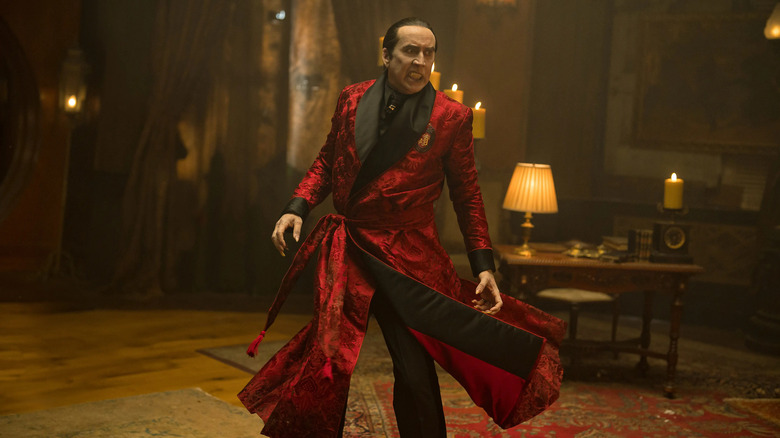
This article contains spoilers for "Renfield." The Marvel Cinematic Universe has made post-credits (and mid-credits, and mid-mid-credits) scenes commonplace these days, with nearly every genre of cinema feeling free to utilize the space during the end credit roll to toss in additional material. That space used to be the near-exclusive domain of the comedy movie. Beginning somewhere around the 1980s, some comedies inserted scenes both during and after the credits (as in 1986's "Ferris Bueller's Day Off"), some included blooper reels (as in 1980's "Smokey and the Bandit II"), while others hid jokes inside the credits themselves (as in 1984's "Top Secret!").
While the mid- and post-credits format is still relatively young enough that it can be experimented with, that doesn't quite explain what exactly is going on with the end credits for "Renfield." A comedy-horror-action movie, "Renfield" is exactly the type of film to put little jokes and bits into the end credits, and sure enough, the film's main-on-end title sequence is full of little callback gags and Easter eggs.
Yet it's the montage of footage that plays under the end credit roll proper that contains the most curious elements, including what appears to be deleted shots to footage that may indicate an entire musical number was excised from the movie.
The Missing Moments Of Renfield
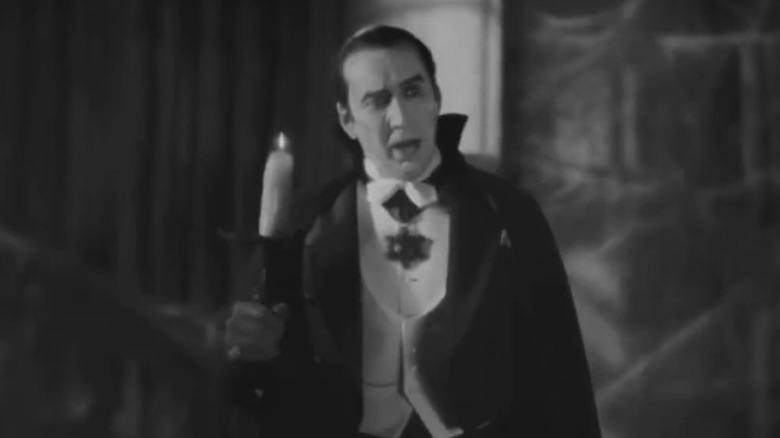
If you've seen both "Renfield" and its trailer, you're likely already aware of some changes to the film that were made during post-production. Some dialogue and shots can be seen in the trailer that are not present in the final release of the film, including Rebecca (Awkwafina) exclaiming that Renfield is "like the guy who gets the villain's Postmates!" Little changes like these between a movie's marketing materials and its final cut are highly common, especially with regard to comedies, which often try out variations on one-liners and such.
"Renfield" is a tight 93 minutes long, so it's no surprise that there exists some footage on the cutting room floor. The film opens with a sequence depicting Nicholas Hoult's Renfield and Nicolas Cage's Dracula either inserted into or re-enacting scenes from Tod Browning's 1931 "Dracula," and that's just the first of many references to past Dracula films that director Chris McKay put in the movie.
The end credit footage seems to reveal that more homages featuring Cage were filmed, including one shot that mimics the heavy candlelit look of John Badham's 1979 "Dracula," with Cage dressed in a costume reminiscent of Frank Langella's from that film. There also appear to be a few shots of Cage's Dracula in a top hat and coat that seems to recall Gary Oldman's Count from 1992's "Bram Stoker's Dracula." Cage wears the outfit in the film proper, but it's onscreen for only a very brief amount of time. Perhaps McKay deleted these other, longer shots and moments for fear of the movie becoming too much of a reference-fest.
Renfield: The Musical?
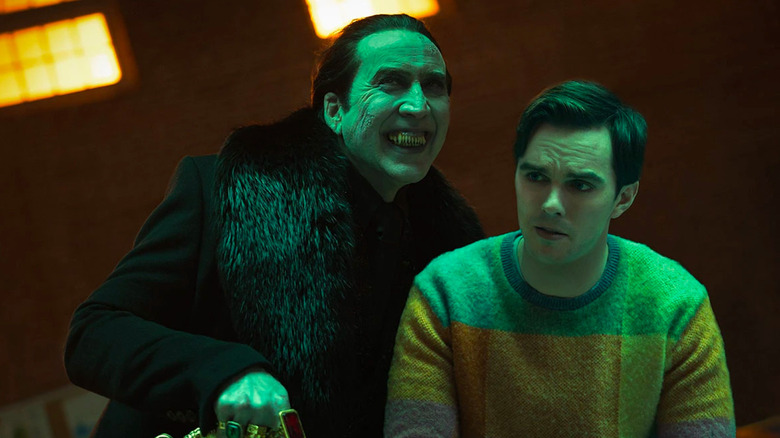
It's a bit difficult and awkward to tell which footage in the end credits was in the movie or not, as the montage intersperses reprises of recognizable moments from the movie itself. It's not hard to assume that the entire reel is just a montage of stuff we've already seen.
Except for a couple of peculiar shots near the end, which depict Renfield sauntering down a street being followed by a crowd of people who appear to be dancing, all while Renfield looks to be singing. A few moments later, there's a shot of Renfield with the night sky behind him lighting up with fireworks while he appears to be holding a climactic note.
If it looks like a musical number, and it dances like a musical number ... is there a musical number that was shot and then deleted from "Renfield?" It wouldn't be the first time an elaborate musical sequence was discarded from a comedy: 2013's "Anchorman 2: The Legend Continues" contained such a scene. That number was eventually uncovered as part of the movie's home media release, included within an entire alternate cut of the film.
Could this mean that an extended or alternate cut of "Renfield" might emerge in the future? Universal Pictures have been known to release extended versions of their movies recently, as seen with "Jurassic World: Dominion" and "F9," so it's highly possible. If we're lucky, the footage may turn up as a deleted scene, but it seems like McKay and company thought that a movie featuring both Nicolas Cage as Dracula and a musical number might be a little over the top.
One thing's for sure, though: comedies still have the most intriguing end credit gags, and you should especially pay attention to the end credits of "Renfield," as there might be even more secrets hidden within.
Read this next: The 30 Scariest Horror Movie Monsters Ranked
The post Let's Examine Renfield's Deeply Weird Credits Scenes appeared first on /Film.
Natalie Remains The Heart And Soul Of Yellowjackets In Season 2

This post contains spoilers for "Yellowjackets" season 2.
"Yellowjackets," named for the girls' soccer team that get stranded in the wilderness after a plane crash, follows its characters in both adolescence and adulthood with alternating timelines. This enables the show to contrast how they've changed (or haven't). When we meet the original four leads in the series pilot, they mostly seem to have moved on from what happened.
Taissa (Tawny Cypress) is the only one who is "successful" in a stereotypical sense — a well-to-do lawyer now running for New Jersey State Senate. But Shauna (Melanie Lynskey) is a bored housewife and Misty (Christina Ricci) has a stable job as an elder care nurse; there are definitely worse fates considering what they went through. The only exception is Natalie Scatorccio. Played in conjunction by Sophie Thatcher in 1996 and Juliette Lewis in 2021, we first meet her in rehab and it's soon revealed this isn't her first time walking the twelve steps.
Since her life has turned out messier than her former teammates, the audience assumption from the outset is that Natalie is the most scarred of the four. The pilot's introduction of her is even cross-cut with a flashback of the cannibalistic survivors butchering a kill, followed by present-day Natalie saying she "lost her purpose" after being rescued. This is quite ominous and hints that Natalie could have been one of those fur-coated killers. But as we get to know her, it becomes clear that Natalie is really the Yellowjacket with the strongest moral compass, both in the past and the present.
Natalie's Story
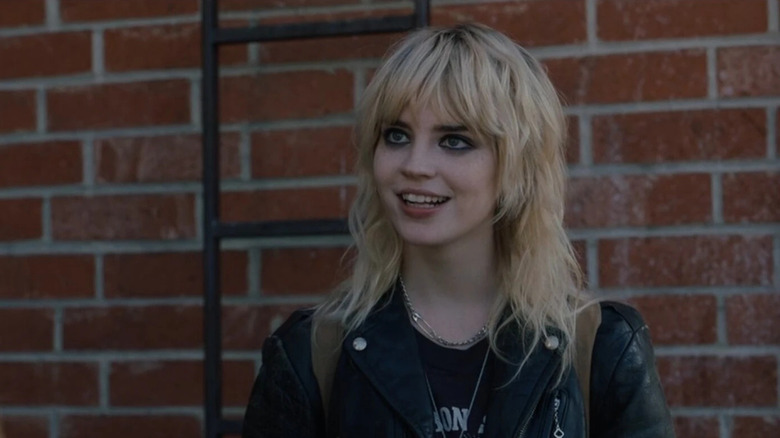
Teenage Natalie is introduced as a punk-rock goth; she gets along with her preppy teammates, but she doesn't run in the same circles when they're not playing soccer. Season 1, episode 4, "Bear Down," dug into her past and revealed why she puts up walls around her. Raised in a trailer park with an abusive father, Natalie once pointed a shotgun at him during one of his rages — she pulled the trigger but the gun jammed. Her father took the shotgun back, they called each other worthless, then the gun misfired and killed him.
Since Natalie knew how to use a gun, she adapted easiest to life away from civilization, becoming the group's hunter once they find a cabin with a shotgun. As the group's most practical member, she becomes friends with the now one-legged Coach Ben Scott (Steven Krueger). Their friendship isn't overplayed, but it's also quite sweet. Ben even admits to Natalie that he's gay (still a no-no in the 1990s) and she's accepting. In "Doomcoming," when the rest of the group gets violent after ingesting psychedelic mushrooms, the two of them stay sober and have to again be the voices of reason.
Natalie also had a fling with Travis Martinez (Kevin Alves), the son of one of the Yellowjackets' coaches who died in the crash; their mutual survivors' guilt over their dead fathers brought them together. The mutual feelings survived the break-up and that leads to Natalie's storyline in the present. After Natalie receives a postcard bearing the insignia the Yellowjackets discovered in the woods, she tracks down Travis and then finds him dead by hanging on the ranch he worked. To an outsider, it looks a like a suicide, but Natalie senses a ritualistic murder. So for the rest of the season, she investigates Travis' death.
Natalie And Misty Sitting In A Tree
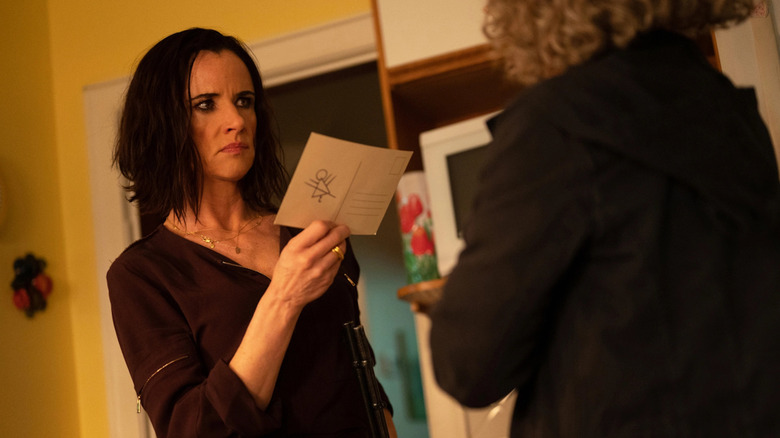
This is the most selfless goal of the main characters. Shauna and Taissa are more in it for self-preservation, especially once someone starts blackmailing the surviving Yellowjackets. Misty is in it for fun and friendship — which brings us to the best character pairing in the show.
Christina Ricci may find Misty strangely relatable, but none of the other Yellowjackets agree, least of all Natalie. However, Misty has a side hobby as a "citizen detective" who solves true crimes. When Natalie re-enters her life brandishing a shotgun and the mysterious postcard, Misty starts clinging to her like a remora.
Natalie resents the company of "that conniving poodle-haired freak," but they're the most entertaining duo in "Yellowjackets" because of how different they are: one has a hard heart but a good soul, whereas the other is harmless-looking but dangerous on the inside. Both Lewis and Ricci are masters of acting with facial expressions and the former's eyebrow-raised, puckered-lips exasperation is perfectly used against the latter's fast-talking mania.
Now, Misty's definition of friendship is different from most people's. She plants a camera in Natalie's motel room, really to satisfy her nosiness but also to "protect" her bestie. When Natalie buys some coke, the always-watching Misty bursts into the room, knocks Natalie down, and then snorts the drug first to keep Natalie on the wagon ("It burns, is that normal?!").
Unfortunately, Natalie and Misty have been separated for season 2 thus far. At the end of season 1, Natalie considered suicide after concluding that's what Travis' death really was. Before she could pull the trigger, some people dressed in purple burst into her room and abducted her.
Season 2

It turns out these were followers of Lottie Matthews (Courtney Eaton/Simone Kessell), the Yellowjacket who developed seer abilities (or hallucinations) in the woods. Natalie has spent the season thus far in Lottie's hospitality, putting her in a new environment but that one that reaffirms her strengths.
Despite the sinister ending of season 1, it turns out Lottie's "community" isn't the human sacrifice, "Midsommar" kind, but more the spiritualistic self-help kind. Natalie was abducted not because she got too close to the truth about Travis' death, but to stop her from committing suicide.
Lottie does know the truth about Travis' death, but she didn't murder him (or so she claims). Lottie tells Natalie that Travis was having visions of the wilderness, reached out to her for help, and ultimately performed the ritual himself to get close to death and communicate with whatever was haunting him. Then the crane Travis used to hang himself malfunctioned and he actually died, with Lottie to bear witness.
Different Types Of Healing
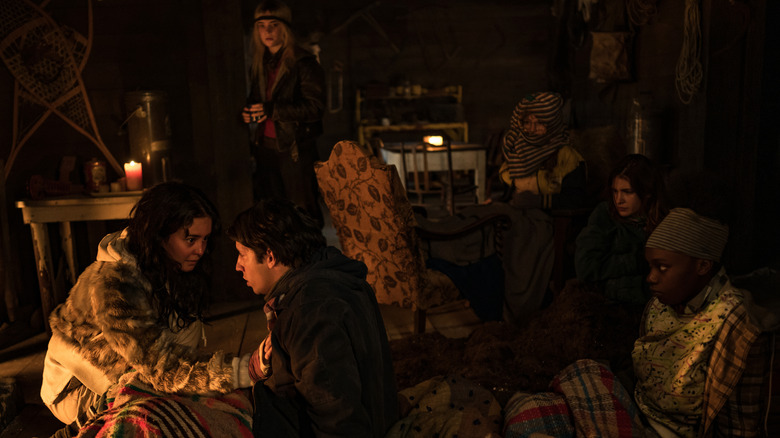
Natalie is naturally skeptical of Lottie and the flashback storyline shows that is another way she hasn't changed. In the past timeline, most of the Yellowjackets are falling under Lottie's sway, thanks to her coping techniques and seeming ability to communicate with the forest they're trapped in. Past-Natalie and Ben are the only ones who aren't falling for it. After the season 1 finale, Travis' little brother Javi (Luciano Leroux) is missing; Natalie thinks he's dead and wants Travis to accept that while Lottie encourages Travis to keep his hope alive. Lottie encourages people to live with their pain while Natalie thinks you should bury it.
Natalie's backstory means it makes perfect sense why the writers chose her as the one to reconnect with Lottie this season. Lottie's followers are people living with trauma who came under her sway hoping to be the best versions of themselves. Someone who's been in and out of rehab for decades can understand that.
Juliette Lewis has said of Natalie's arc this season: "Somewhere within Natalie, now that she's landed in the care of older Lottie at a compound, she's seeking truth. She's seeking answers to what happened and redemption. She's not medicating, so she's wide open to figuring out life, which is unusual for that type of person."
Old Wounds
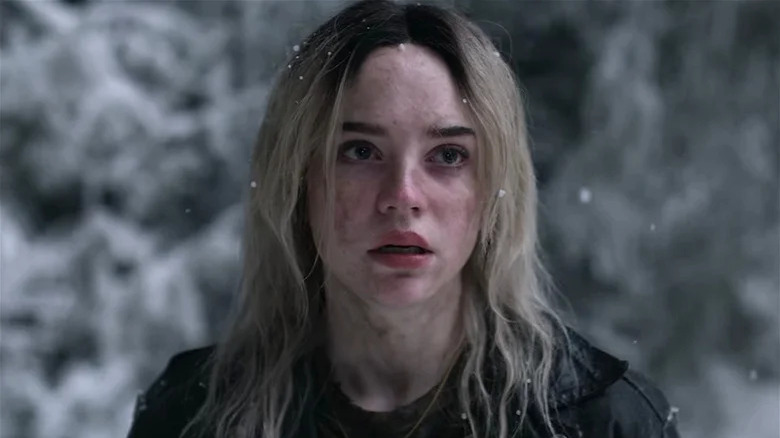
The most recent episode, "Old Wounds," was a big one for Natalie, both in the past and present.
In 2021, Natalie befriends Lottie's follower Lisa (Nicole Maines). They got off on the wrong foot in the premiere — Natalie stabbed her hand and face with a fork while trying to escape — but Lisa apparently doesn't hold a grudge. While on a ride to the group's farmer's market stand, they stop at Lisa's childhood home.
Lisa's mother doesn't approve of her lifestyle and despite Natalie's own skepticism, she sticks up for Lisa: "You can't let your daughter be happy?!" As another friendly gesture, she smuggles Lisa's pet goldfish out of the house (in her mouth, no less). Afterward, they hit the bar and connect further over their shared history of suicidal ideation.
In 1996, Natalie's conflict with Lottie came to a head when Mari (Alexa Barajas) suggested the group's antler queen could be a better hunter than Natalie. So, they have a hunting contest. Natalie finds a Moose corpse lodged in the surface of a frozen lake and falls in while trying to get it out. Lottie hallucinates the crashed plane that Laura Lee (Jane Widdop) died trying to pilot last season and after a surreal vision, blacks out and nearly freezes.
While they're both recovering with hot baths back in the cabin, they reconnect over their mutual failure. In the present, though, it looks like their conflict is only beginning. Lottie's visions (or hallucinations) from the wilderness are returning, while Natalie swiped the keys to Lottie's office.
What's Next For Nat?
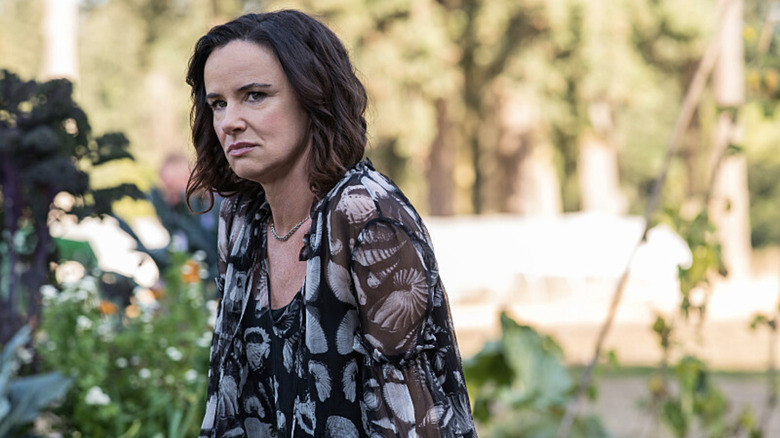
Now, despite her good heart, Natalie isn't flawless. In episode 2 of this season, "Edible Complex," she tried to convince Travis of Javi's death by raiding his suitcase and spilling her own blood on a piece of his clothes she "found in the woods." This was underhanded, to put it mildly, especially since "Old Wounds" revealed Javi's actually still alive.
Given her disagreements with Lottie, I was also expecting Natalie to abstain from cannibalism, but in "Edible Complex," she chowed down on the charred Jackie with the rest of the team. At least she had the courtesy to lay what was left of Jackie to rest in the next episode, especially since they hadn't been friendly back in season 1.
Still, does this mean the pilot's visual clues were correct and Natalie will turn out to be one of the hunters who killed the mysterious Pit Girl? Her continuing distrust of Lottie tells me no, but "Yellowjackets" is a dark, weird, and surprising enough television program that is capable of painting its heart and soul black.
New episodes of "Yellowjackets" stream on Showtime every Friday and air on television every Sunday.
Read this next: The 15 Best Comedy Duos Of All Time
The post Natalie Remains The Heart and Soul of Yellowjackets In Season 2 appeared first on /Film.
Yellowjackets Might Be Heading In A Stephen King's Pet Sematary Direction, And We're Scared
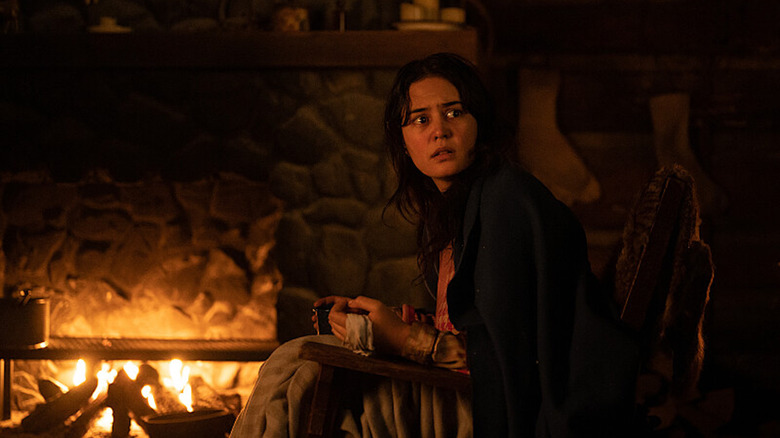
This piece contains spoilers for "Yellowjackets" season 2, episode 4.
It's only been a season and some change, and "Yellowjackets" has already given us so much. We've seen cults, blood rituals, amputation, murder, dog murder, possession, dramatic sleepwalking, and no one will be able to forget the ungodly traumatic feast of season 2, episode 2's big cannibalism scene. With the conclusion of this week's episode, "Old Wounds," we may soon be adding another one to that list: resurrection.
While the rest of the girls are placing their bets on the big hunting competition between Nat (Sophie Thatcher) and Lottie (Courtney Eaton), Van (Liv Hewson) and Taissa (Jasmin Savoy Brown) hatch a plan of their own. Throughout the angrier, more unhinged second season, Van has been waking up with Taissa in the middle of the night to follow her around on her sleepwalking adventures. She finds that each time Taissa ventures out, she ends up at a tree inscribed with the mysterious symbol that continues to haunt the Yellowjackets into the present. After plotting all these trees out on a map, she finds that — surprise, surprise — they are themselves points that make up a larger version of the symbol.
Still terrified of her own mysterious connection to the woods, Taissa rejects the theory. But Van is able to convince her to make one more journey to the final point that would complete the symbol on the map. She's desperate to find proof that there's some larger design to what's happening in the woods. What she and Taissa do eventually find out there only raises more unanswerable questions.
Are We Out Of The Woods?
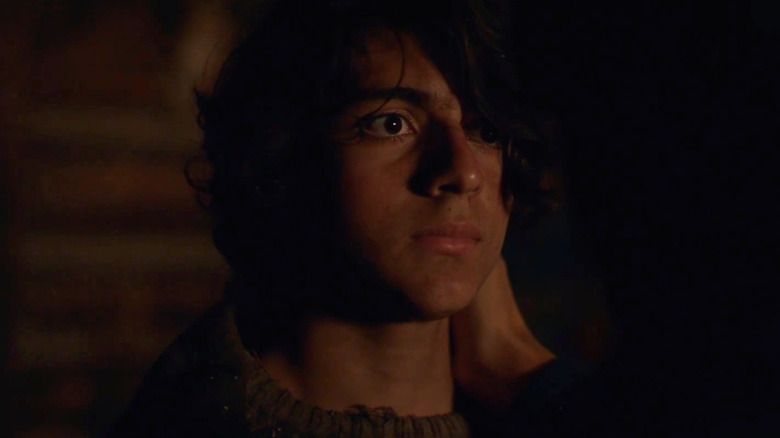
The rest of the Yellowjackets are moping in defeat after both Nat and Lottie return empty-handed when, in a flash, an awe-struck Van and Taissa usher a third person into the cabin. It's Javi (Luciano Leroux), Travis' (Kevin Alves) little brother, who went racing into the woods during the magic mushroom meltdown in season 1's "Doomcoming" episode. He hasn't been seen since, despite Nat and Travis' constant efforts to track him. Nat eventually gets so worn down by the search, so concerned over Travis' inability to start working toward closure, and so anxious that Lottie's insistence that Javi is alive will draw Travis further under her influence, that she blots some blood on one of Javi's old pant legs and presents them to Travis — "proof" that he's not in a state worth looking for.
We catch one brief glimpse of a chastened Nat ducking into the shadow and away from Travis' gaze, as he pulls Javi into a wonderstruck hug. The girls then start drawing out all the implications of Javi's ultimate survival against the elements. "This means Lottie is right," says Mari (Alexa Barajas), "She's the one who said Javi was alive." Van adds that, sure, "Lottie knew he was alive, but Taissa knew where he was." What's at the root of Taissa and Lottie's mystical connections to the wilderness? We know that neither of them are able to outrun or even control these supernatural gifts over two decades later.
But the more important question that the girls seem (at least for now) to sail past is, how in the world did Javi survive? He says nothing during his brief scene in the episode, but an empty, yet restless look in his eyes might testify to something more foreboding than anyone has realized.
Don't Fear Death, Fear The Life After
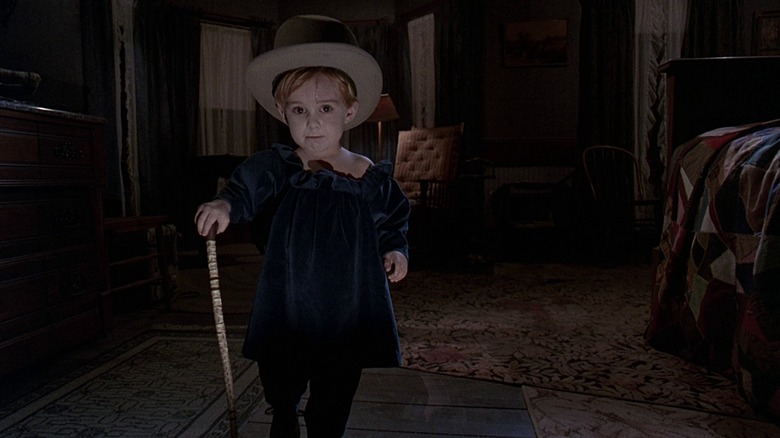
If you've been watching "Yellowjackets" closely, Javi's return isn't altogether surprising. Nat's misguided saga to protect Travis was definitely building to something, but I have a feeling that the revelation she faked evidence of Javi's death is only the beginning of a pitch-black turn in this storyline.
When Travis sees Javi he mutters, "How the hell are you alive?" and pulls him into a hug. Javi is not only physically unresponsive to the hug, but when Travis pulls away, Javi's nearly expressionless eyes, tinged with the faintest trace of unspeakable dread, drop away. "Javi, hey, it's me. It's your brother," Travis continues, nervously. Director Scott Winant handles this part of the episode deftly, cross-cutting between Travis and Javi for only a few moments before the girls pivot the conversation away.
It's a blink-and-you'll-miss-it indication that, while it's amazing Javi has been recovered, he may not have come back entirely himself. Those narrow, haunted eyes instantly recalled for me the eyes of the resurrected in Stephen King's "Pet Sematary," a novel about the lengths people will go to to defy death. As far as spilling your blood on a sylvan altar, perhaps? One part of Lottie's psychedelic hunting trip showed her letting a slash of her blood onto a mysterious shrine found in the woods — possibly the charm that conjured Javi forth only moments later. From the very first scene in the pilot, "Yellowjackets" has been moving toward cannibalism, blood rituals, and "Battle Royale"-style violence. But perhaps survival isn't the endgame of all this barbarism. Perhaps it's something less base, something transubstantial, inexplicable, and irreversible.
How did someone as young as Javi survive alone in the woods alone for that long? Maybe he didn't? If it turns out that death is not the end in "Yellowjackets," then this is a whole new beginning.
Read this next: Yellowjackets Post-Cannibalism Clarity Is Hard To Swallow
The post Yellowjackets Might Be Heading in a Stephen King's Pet Sematary Direction, and We're Scared appeared first on /Film.
Who's Stealing The Bear Meat In Yellowjackets? An Investigation
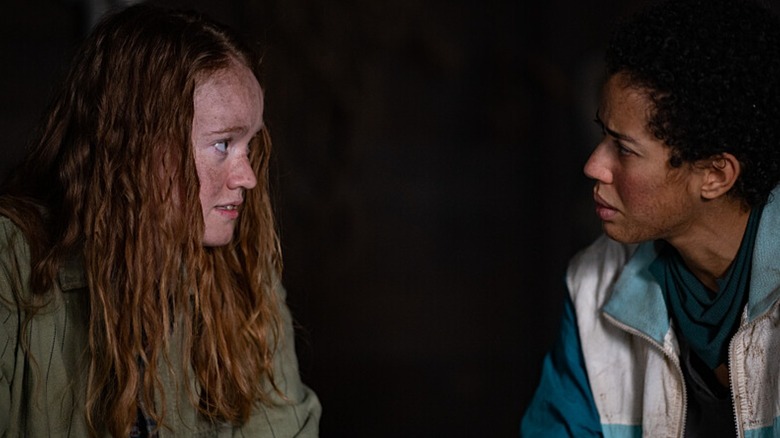
This post contains spoilers for the latest episode of "Yellowjackets" season 2.
"Yellowjackets" is a show that thrives on mystery. At any given moment, the show is juggling about a half-dozen lingering mysteries, from the identity of the no-eyed man to the sinister French whispers in Lottie's ear to the fate of Shauna's baby. The show would be great even without loading up on mysteries — it's an excellent coming-of-age story, survival saga, and horror show.
Yet "Yellowjackets" is enriched by its mysteries, and at this point, there are so many to keep track of that new ones can get lost in the shuffle. Case in point: this week, in one of the show's '90s-set scenes, we learn that someone's been sneaking extra bear meat. "So who's the thief?!" Shauna (Sophie Nelisse) says with accusatory passion. "I guess they think they deserve more than the rest of us, which, at this point is pretty f***ed." A conversation about possible culprits doesn't get anywhere, and the team is soon distracted by what they consider a more pressing issue — a test of Lottie's (Courtney Eaton) mysterious abilities.
That's all well and good, but who did steal the bear meat? As rations get more scarce and winter grows harsher, the only way the team will avoid eating more of their own — or dying of malnutrition — is if they have enough meat to go around. Plus, whoever did steal the bear meat is more and more likely to get iced out if they don't confess, and we know how that worked out for Jackie. The girls might be distracted from the bear meat mystery, but we're not: let's take a look at the suspect list, shall we?
Coach Ben
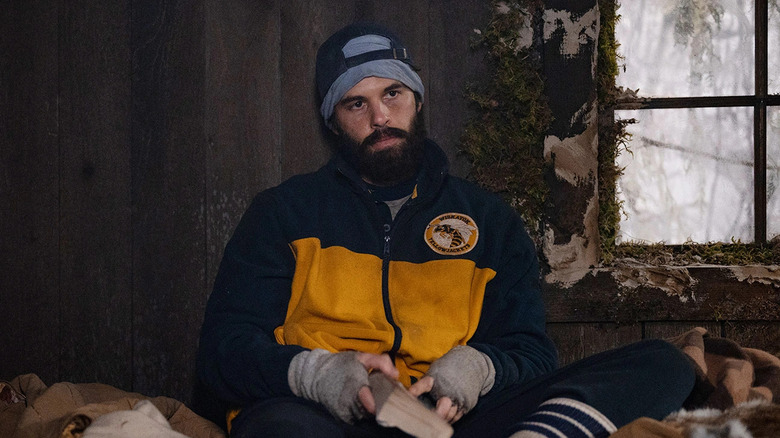
Poor Coach Ben (Steven Krueger) is the only person who didn't eat any of Jackfruit Jackie when the group's dead teammate was inadvertently smoked by snowfall a few episodes ago. In fact, he doesn't seem to be eating much of anything at all lately, instead spending his time in what might be hunger-induced hallucinations about the boyfriend he had and lost back home.
Ben is the only person who gets outright accused of taking the bear meat in this episode. "It's probably him," Mari (Alexa Barajas) whispers to Akilah (Nia Sondaya). "He thinks he's so much better than us." This is a reference to Ben's refusal to partake in cannibalism, but he has a good defense. "In case you forgot, I'm not exactly nimble in the snow," Ben says, insisting he's innocent. I believe him, but he does have a motive: Coach Ben has to get calories somehow or he'll starve and end up roasted on a spit. If he didn't take it himself, maybe one of the girls took mercy on him and swiped some rations for him.
Taissa
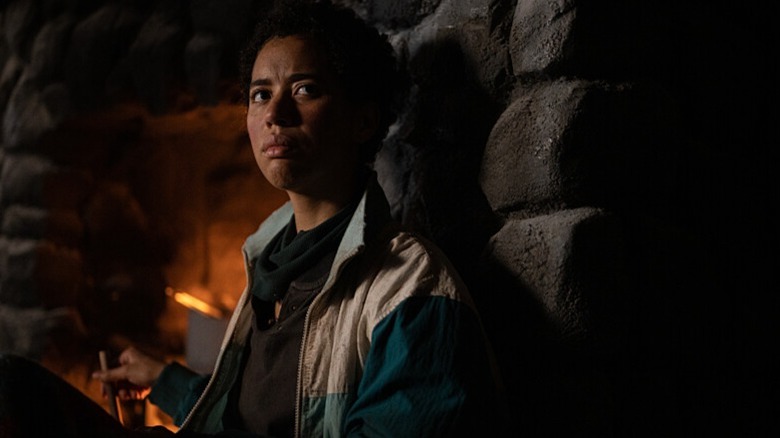
Food theft sounds like the kind of crime that comes from desperation and impulse, but what if it's actually being done without any conscious awareness? "Yellowjackets" has tried to convince us that Taissa (Jasmin Savoy Brown) has been bringing Van (Liv Hewson) with her on all her sleepwalking excursions this season since the pair are tied together at night. But it's become unnervingly clear that night-time Taissa is, on some level, a whole other person capable of making distinct decisions of her own. Could she be untying herself from Van in the night and stealing rations to satisfy some primal hunger?
There's actually some evidence to support this. For one, we just saw that Taissa is certainly capable of sleep-eating; she was apparently totally out of it when she chowed down on Jackie's face. For another, there's actually another mini-mystery that parallels the meat theft. In episode two, we learn that someone pooped in the group's bathroom bucket during the night, and also stole the lamp. No one fesses up, and it seems like a random thing to do by choice. Is it possible that night-time Taissa is the bear-swiper, bucket-pooper, and lamp-stealer all in one? It seems likely, in which case, I'm curious to see where that lamp could turn up.
Javi
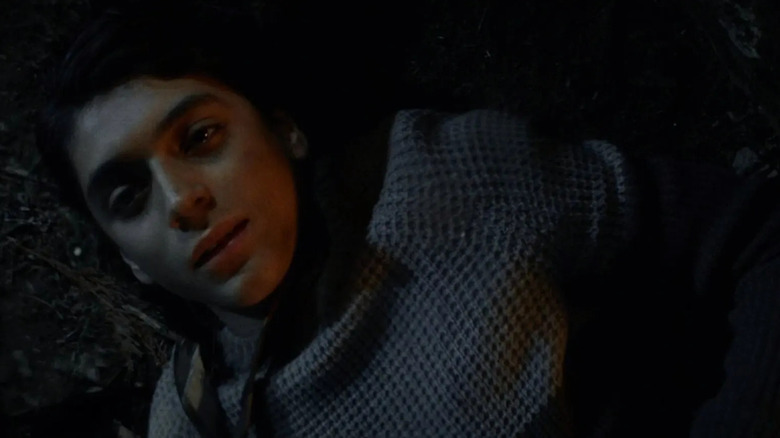
The final moments of this week's episode revealed a wild twist; Javi (Luciano Leroux), who ran for his life during "Doomcoming" and seemingly never looked back, is still alive! The boy returns from the wilderness silent and seemingly memory-less. He's seemingly deeply traumatized if not entirely feral from his time in the forest. It's been an extremely harsh winter already, so how did Javi survive out there?
"Yellowjackets" loves to offer up both logical and belief-defying explanations for its most unsettling moments, and let audiences dwell in the ambiguous middle ground. Javi's survival already feels like another example of this. Everything we know about this creepy place makes it easy to believe that Javi was kept alive by the sinister spirits of the forest, but is it possible he got some human help?
In the season premiere, Natalie (Sophie Thatcher) and Travis (Kevin Alves) see a surprisingly lush stump with signs of melted snow around it but don't investigate. Javi may have been living there, and either stealing rations himself or getting them delivered to him by a member of the group. It's unclear if this is the same stump where Lottie, Van, and Misty (Samantha Hanratty) left the bear's heart as a sacrifice at the end of last season, but if so, Javi could've made a meal of that, too.
Lottie
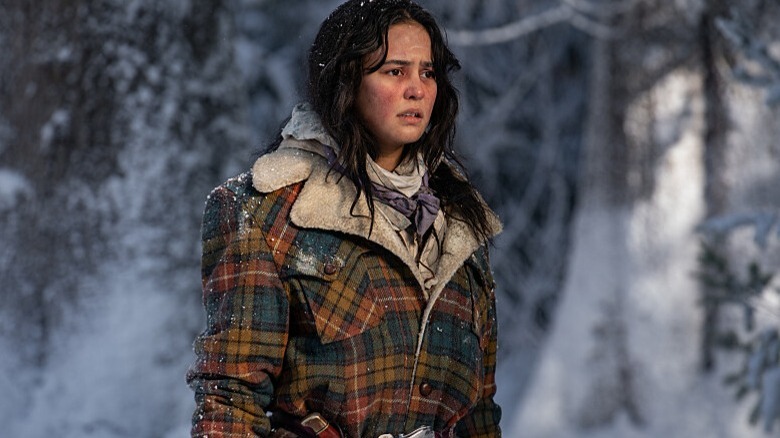
Speaking of Lottie, if anyone has a penchant for doing some wild nonsense and feeling exactly zero need to explain it to anyone else, it's her. This episode is frank about Lottie's history of mental illness, as the adult version of the character (Simone Kessell) speaks to a psychologist about upping her medication in the wake of her returning visions. This scene comes soon after the bear meat dilemma is presented, but we also don't need much convincing that Lottie would do something over-confident and eccentric like repurpose bear meat without asking.
If Lottie were to get caught red-handed, it seems likely that the more superstitious girls would use this as more evidence that she's creepy and manipulative. Yet it really does seem like Lottie is just trying to protect the group in her own way, and the neo-pagan rituals she's been employing seem a lot more related to blood than flesh. I imagine that if she were to steal food, it would be to help someone who needs it — like Ben, Javi, or Shauna.
Shauna
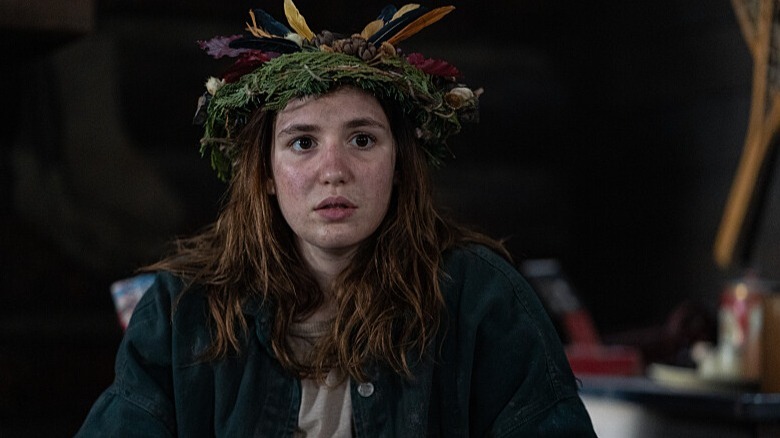
Of course, there's also the age-old "you smelt it, you dealt it" defense, which points the finger directly back at Shauna. There's nothing overtly suspicious about the way Shauna delivers the news that the bear meat has gone missing, but she does have means, motive, and opportunity. As the only pregnant person in the group of starving teens, her daily calorie intake surely needs to be more than it is, and I wouldn't fault her for dipping into the rations on the side.
While Shauna's accusations may seem counterintuitive if she's the thief, we've seen that as a grown-up, Shauna (Melanie Lynskey) is great at deflection and manipulation. When it comes to covering up her affair with Adam and his eventual murder, she always tells everyone just a little bit more of the truth than you'd expect her to, and that honesty hides a false wall behind which more lies are hidden. Shauna may be the least likely culprit on this list, but if she did steal the bear meat, then turn around and report its theft, she may have pulled off the perfect crime.
Alas, it might be a while until we see the culprit in the great bear meat caper unmasked, as Javi's return, Van's investigation of the hunter's symbol, and Lottie's increasingly trippy visions have all taken center stage. In the meantime, though, we'll keep an eye on these suspects — this back-burner mystery might eventually get someone cooked.
Read this next: Every Yellowjackets Main Character, Ranked
The post Who's Stealing The Bear Meat In Yellowjackets? An Investigation appeared first on /Film.
The Service Accounts Challenge: Can't See or Secure Them Until It's Too Late
Google Launches New Cybersecurity Initiatives to Strengthen Vulnerability Management
Review: Minecraft Legends
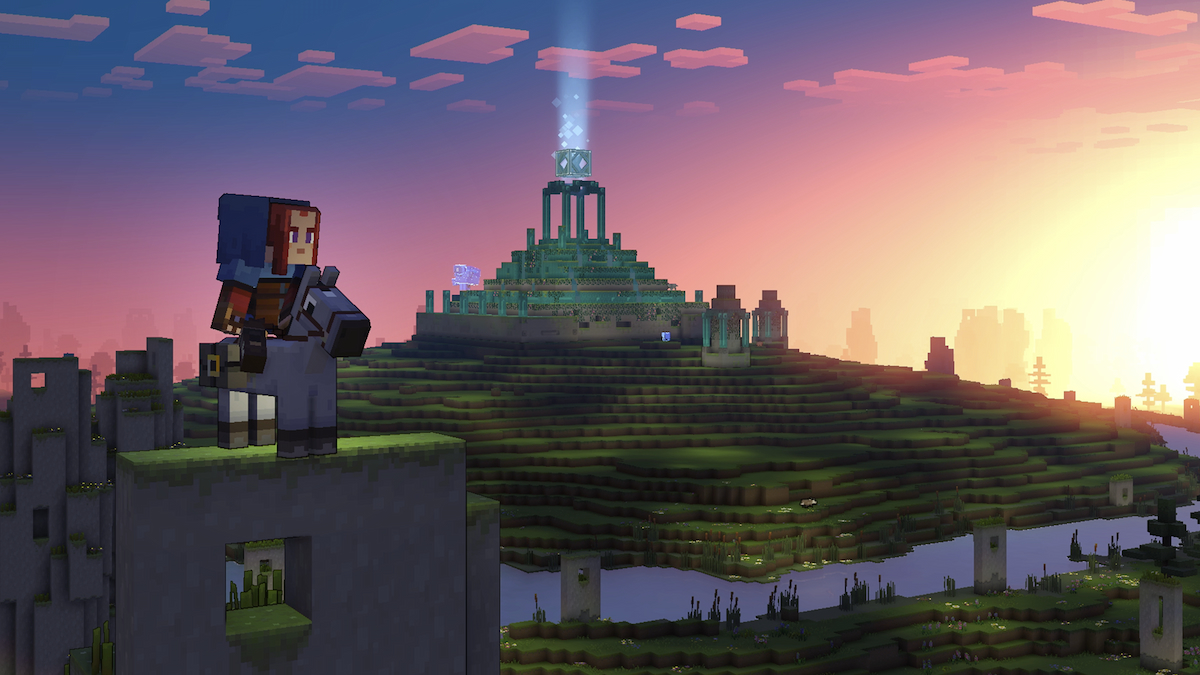
Age of Minecraft
Minecraft the game and Minecraft the franchise are two different, yet equally fascinating beasts.
Minecraft needs no explanation. If you’re reading this, I’m sure you already have an opinion on it. But its many spinoffs haven’t necessarily stayed true to more than Minecraft’s overall aesthetic. Minecraft: Story Mode gave us a Telltale narrative adventure when that was the rage, and Minecraft Dungeons asked “What if Minecraft was Diablo?” Minecraft Legends is the newest game in this extended Minecraftian Universe, this time introducing the blocky world to the strategy genre.
Some may take umbrage with these Minecraft spinoffs, but I’m in favor of them. I never got invested in Minecraft proper; I just wasn’t in the right time and place at the height of its popularity. That said, mixing new genres with the Minecraft DNA is the perfect way to get people like me invested in the franchise. Coming in with a mostly blank slate, I genuinely didn’t know what to expect from Minecraft Legends. Fortunately, my time with the game has left me with a greater appreciation for both Minecraft and the strategy genre. It’s just Minecraft Legends itself that I’m on the fence about.
[caption id="attachment_373710" align="alignnone" width="640"] Screenshot by Destructoid[/caption]
Screenshot by Destructoid[/caption]
Minecraft Legends (PC [reviewed] Xbox One, Xbox Series X|S, Switch, PS4, PS5)
Developer: Mojang Studios, Blackbird Interactive
Publisher: Xbox Game Studios
Release: April 18, 2023
MSRP: $39.99
Minecraft Legends is a Real-Time Strategy (RTS) game. The developers have shied away from this label, likely for reasons that should become clear during this review. That said, I can’t think of a better descriptor for what Minecraft Legends is at its core. You collect resources, build settlements, and rally small armies of disposable troops to launch attacks on enemies. If you’re familiar with the gameplay loop of other RTS titles, you’ll have a step up coming into Minecraft Legends.
The difference is that Minecraft Legends attempts to make this PC-specific genre click in a console environment. It’s not the first game to attempt such a feat (mention Brutal Legend in the comments for free internet points), but this nonetheless gives Minecraft Legends a distinct identity. To achieve this, you directly control a player avatar that not only issues all commands but participates directly in battle. The result is right in the middle of Pikmin and Age of Empires, with a dash of Minecraft’s core gameplay.
It's a sound mixture of ideas, and I really like the approach Minecraft Legends takes here. The controls take an hour to get the hang of, but the basics are easy to grasp in a handful of minutes. Additionally, if you’re familiar with Minecraft, two of the three main pillars of the game will come naturally. In fact, before we get into the game modes Minecraft Legends puts in front of you, we have to review these core mechanics in isolation.
https://www.youtube.com/watch?v=lw6f-tJKoao
The mining is good
It’s a bit silly to say out loud, but the mining and crafting in Minecraft Legends are its strongest elements.
Just like Minecraft proper, you want to find stacks of resources stemming from distinctly colored blocks. However, rather than smacking them yourself with a pickaxe, you issue orders to gather specific materials in an area. This will summon an Allay, a dedicated fairy-like unit whose sole existence is to gather things for you. If you’ve played other RTS games, this isn’t terribly different than sending a unit to indefinitely chop down trees. That said, ordering Allays around is instantaneous and oddly satisfying. I’d often be en route to an objective and see materials I’d need on the ground, so I’d bark a command at an Allay without even bothering to stop.
There’s a nice element of strategy here. You can order an Allay to collect a literal mountain of rocks for you, but that will tie up one of your limited number of gatherers for several minutes. Meanwhile, if you don't order Allays around, you're missing opportunities to earn stacks of valuable resources. Whether you should hold Allays or use them all for passive resource gains makes for a natural risk/reward system, which fits well within Minecraft Legends. It's an elegant mechanic that the game absolutely nails.
[caption id="attachment_373707" align="alignnone" width="640"] Screenshot by Destructoid[/caption]
Screenshot by Destructoid[/caption]
The crafting is good
Similarly, using your materials to craft buildings is also satisfying. When fending off enemies, Minecraft Legends closely resembles a Tower Defense game. You’ll have to protect your home base with a series of walls, arrow towers, and other buildings that will augment or heal your existing foundation. Like mining, crafting in Minecraft Legends uses its own pool of Allays. Issue an order for something to be built in one spot, and an Allay will build it brick by brick.
It's a great system, as it performs well in different contexts. In times of peace, erecting your settlement is fast and easy. You’ll spend a limited amount of time on minutia and focus solely on where you want things built. Similarly, when you’re under attack, you can frantically order Allays to patch walls and work on other constructions while you’re mid-combat. This adds a fun, frantic element to the defensive gameplay. When your units are struggling to fend off an army, it’s satisfying to slap four arrow towers around your army to provide some extra firepower.
There aren’t many building types in Minecraft Legends, but I don't see this as a negative. This is more of a Smash Bros. take on the RTS genre, so it doesn’t necessarily need the complexity that other titles have. Additionally, there’s still room for advanced strategies and player creativity with the tools provided. There do seem to be some balance issues, but I imagine Mojang and Blackbird Interactive will tweak things as time goes on. Unfortunately, Minecraft Legends has greater issues than its balancing.
[caption id="attachment_373709" align="alignnone" width="640"] Screenshot by Destructoid[/caption]
Screenshot by Destructoid[/caption]
Going on the attack is… well…
The third pillar of Minecraft Legends is its attack phase. When you’re ready to take down your opponent, you’ll gather a small squad of units around you and charge headlong into battle. On paper, this looks nice. You have a concise selection of units to pick, ranging from healers to stun-focused melee fighters. Additionally, you can summon classic Minecraft monsters like Skeletons, Creepers, and Zombies to fight alongside you. Even with no attachment to Minecraft, I enjoyed joining forces with former enemies to take bigger baddies down.
Once you’re engaged in combat, your best course of strategy is to…well, kind of hang out. Unlike the Allays—which are conducive to multitasking—your best course of action with your army is to hold down your one attack button. Wiggle around to take out the extra small fry, and hopefully, your army will eventually win. This really slows the action down, as that satisfaction from making snap strategic decisions largely disappears here. You do have to decide when to keep charging and when to retreat, but overall, there really isn’t much engagement here.
Even if your forces can comfortably overwhelm whatever they’re fighting, you still need to be physically present to collect the rewards they drop before they fade away. There are limited options to break up the tedium. Specifically, you can build a catapult that works very well if you're on the offensive. Still, this is one area where Minecraft Legends leans way too hard on simplicity.
[caption id="attachment_373708" align="alignnone" width="640"] Screenshot by Destructoid[/caption]
Screenshot by Destructoid[/caption]
Am I herding cats?
Additionally, your army’s AI is imprecise. If you issue an order to attack a specific structure, your troops will generally rush it from wherever they’re standing. This is bad if you, say, built a ramp to help your group cross a chasm, only to watch 20% of your forces just fall off the side instead. Even when they do obey, they often act in particularly baffling ways. Healing units, for example, usually won't charge into battle if no one needs healing. This might sound smart, but when your front line starts immediately taking damage, they have no intuition to enter the fray and start supporting.
There were so many times when I ran around just to see where my units wandered off to. Even after ordering my team to specifically charge a building or settlement, I had to corral stragglers stuck fighting losing battles by themselves nearby. This gets even worse if you have a mixture of melee and ranged attackers on your team since it is all too easy to miss units when you want to regroup and charge forward.
This isn’t necessarily game-breaking. After all, in a competitive environment, all players are dealing with their respective AIs. I just never felt as in control as I’d like to be for a strategy game. You eventually get a feel for how your army moves, and you can strategically maneuver in ways to help them charge in the direction you want them to. That said, I can’t help but feel this shouldn’t have been a part of the game to begin with.
[caption id="attachment_373742" align="alignnone" width="640"] Screenshot by Destructoid[/caption]
Screenshot by Destructoid[/caption]
Campaign pain
Minecraft Legends has three primary modes. All of them feature this same core gameplay, but with their own unique twist. Unfortunately, the adventure you are funneled into first is by far the weakest of the options.
Campaign Mode thrusts you into a larger map that tasks you with defeating armies of enemy Piglins. Minecraft Legends doesn’t need a more complicated story than that, but this threadbare plot is oddly expressed through many elaborate cutscenes. This sounds weird to complain about, but to avoid spoilers, I can't imagine anyone getting anything out of this. I understand the story is aimed at kids, but more on that later. Regardless, I'm not expecting Shakespeare out of Minecraft, but this isn't even Shark Tale.
If this were my only gripe with Campaign Mode, I’d be okay with it. The problem is the campaign takes Minecraft Legends' core systems intended for games lasting one hour and stretches it to over ten. There are flourishes thrown in here, but you’ll see almost everything worth experiencing shortly after it begins. The one bright spot is village defense missions, which work well because they play to the game's strongest elements. The rest of the story throws you against Piglin waves and bases you’ve already seen, just in bigger and more tedious numbers.
Every campaign features a procedurally generated world, which I can't help but consider a misstep. On one hand, I get that this is a more “Minecraft-y” approach. It also, in theory, makes the game replayable, especially since it supports four-player co-op. That said, when hour three looks virtually identical to hour six, procedural generation doesn’t make the campaign look better. It just exposes how little there is to begin with.
[caption id="attachment_373711" align="alignnone" width="640"] Screenshot by Destructoid[/caption]
Screenshot by Destructoid[/caption]
It's not a tutorial
The bizarre part is the campaign doesn’t even make for a good tutorial. At best, it’s an open-ended playground for you to experiment with Minecraft Legends’ gameplay. But it doesn’t really teach you anything aside from the exceedingly obvious. Even a game as old as Age of Empires 2 threw you into different scenarios that tested your mastery of different aspects of the game. If you strictly judge the campaign against other co-op-focused experiences, it still feels lacking in the end.
In fact, I’d argue the campaign is borderline unnecessary. In a few minutes of PvP practice, I was amazed at how quickly I grasped the gameplay compared to my hours in a solo adventure. There's also a “Lost Legends” mode, which will dish out concentrated PvE missions every month. I tried the one Lost Legend available, and though I was defeated handily solo, I had way more fun here than in the campaign. If there were more missions like these in the game, I'd easily recommend Minecraft Legends as a co-op game.
[caption id="attachment_373712" align="alignnone" width="640"] Screenshot by Destructoid[/caption]
Screenshot by Destructoid[/caption]
PvP is where it’s at
Speaking of PvP, that’s really the main draw of Minecraft Legends. In a competitive environment, the game feels better and makes more sense. While the campaign is tedious, even mundane tasks in Versus mode have urgency when you’re racing against other players. Additionally, upgrades come much quicker in multiplayer, creating a satisfying sense of progression.
I wish I could speak on this more specifically, as my PvP experience was limited leading up to this review. I can say that for an ideal experience, you’ll want at least two teams of two. The early game is slow in 1v1, but more players allow you to delegate responsibilities and make progress much faster. Additionally, because the mechanics ride a fine line of depth and accessibility, Minecraft Legends makes for casual, competitive fun. I can understand that local multiplayer wasn’t on the table for Minecraft Legends, but if it was, I could see this being a fun party game.
Do note that Minecraft Legends doesn’t have a persistent progression system for multiplayer. You won’t level up or earn extra goodies by playing PvP. I don’t hold this against the game. A game should be fun regardless of any breadcrumbs it throws your way. However, if that’s important to you, it’s worth the note regardless.
[caption id="attachment_373713" align="alignnone" width="640"] Screenshot by Destructoid[/caption]
Screenshot by Destructoid[/caption]
Let’s talk microtransactions
One thing I do unfortunately have to discuss is the existence of microtransactions in Minecraft Legends. They toe the line of what some may consider acceptable, but they are here all the same.
Minecraft Legends appears to use the Minecoins currency from Minecraft Bedrock Edition. During my review period, only a pack of player skins was available. However, Lost Legends also had a tab in the marketplace, indicating that there will be microtransactions related to those too (hopefully just content DLC). But assuming only skins will be purchasable, I still dislike the existence of paid skins in Minecraft Legends particularly. By default, only ten (admittedly distinct) skins are available at launch, with a note to check the marketplace for more. Even if they release more skins for free (one is even available as a reward for the current Lost Legend mission), you’re still funneled into a storefront where you’ll be tempted to buy cosmetic items.
Minecraft Legends isn’t the most offensive example of microtransaction slinging, but this inherently makes the game less safe for kids. Considering the main story clearly targets children, this bothers me a lot. I personally know people less literate in video games who have struggled with their kids begging for cosmetics in Minecraft. Perhaps parents are to blame, but the problem wouldn’t exist if the temptation wasn’t there in the first place.
Make of this what you will, but microtransactions alone would prevent me from recommending Minecraft Legends for a young child. I'm sure the argument is that microtransactions will fund the continued release of Lost Legends episodes. Still, you should know that they're there.
[caption id="attachment_373714" align="alignnone" width="640"] Screenshot by Destructoid[/caption]
Screenshot by Destructoid[/caption]
So who is Minecraft Legends for?
Ultimately, Minecraft Legends is a bit hard to evaluate. Everything from its game modes to its core systems is uneven, littered with many highs and notable lows. The parts of it that draw specifically from Minecraft proper come off well, while its more RTS-adjacent moments are lacking. Additionally, I can't recommend playing this solo at all. The foundation is good enough, but it needs company to sustain it.
Your enjoyment of Minecraft Legends will come down to three questions. 1: Are you in love with Minecraft and its extended universe? 2: Are you hankering for an RTS-style game playable on a console? 3: Do you have a minimum of three friends who are eager to play this game too? If you answered yes to at least two of those questions, you’ll have a good time with Minecraft Legends. For everyone else, Minecraft Legends offers a fairly unique experience and not much more. Just don’t expect to get any mileage out of the campaign.
[This review is based on a retail build of the game provided by the publisher.]
The post Review: Minecraft Legends appeared first on Destructoid.
Millennials Spend More Time Playing Video Games Than Gen Z and Teens, New Study Finds
Read more of this story at Slashdot.
Chris Farley Played Jon Favreau On The Improv Stage Before Either Of Them Became Famous
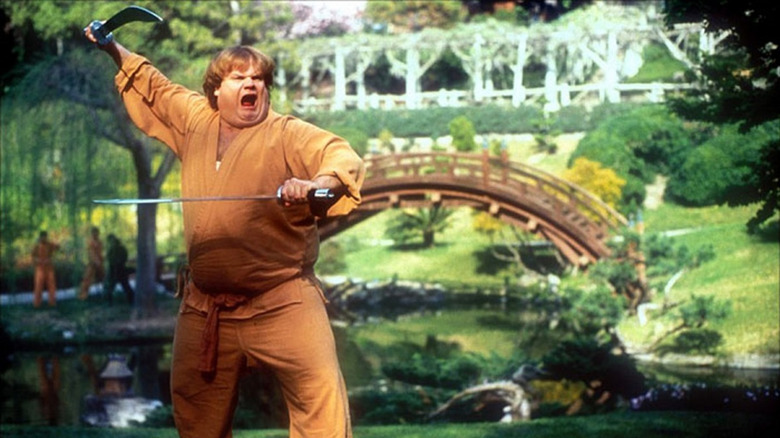
According to various online biographies, director Jon Favreau graduated high school in 1984 and attended Queens College for only three years before dropping out in 1987. As he recently said on an episode of the "Smartless" podcast, he was immediately offered a high-paying job at the investment firm Bear Stearns, hooked up with the gig by a friend's dad. Given Favreau's age, this would definitely be considered "selling out" at the time. The easily earned, large-salary job was once something young aspiring artists eschewed, preferring a hard-earned, low-money career in the arts. (See also "Tick, Tick... BOOM!") Favreau was bitten by the acting bug at a young age and always had his sights turned on performance.
After about a year at Bear Stearns, Favreau quit. It seems he just barely missed Black Monday. It also seemed that he hated it. After another brief try at college, Favreau dropped out again, this time for good, and drove out to Chicago to dive into the city's thriving comedy scene.
Recall that Chicago is the seat of the famed Second City comedy troupe, an extended network of theaters and performers that put on improv and sketch comedy shows all over the city. By the late 1980s, the Second City was a well-known source of talent that was frequently hired to appear on "Saturday Night Live." Many, many aspiring comedians floated in and out of the troupe's orbit, and many others were indeed hired to be part of Lorne Michaels' various sketch programs. Harold Ramis, John Belushi, Dan Aykroyd, Bill Murray, Bonnie Hunt, Dan Castellaneta, Richard Kind, and Alan Arkin are among the school's many famous alumni.
Notably, "SNL" cast member Chris Farley was a graduate. Farley and Favreau, on one fateful night in 1988, were in the same theater together.
The Dream
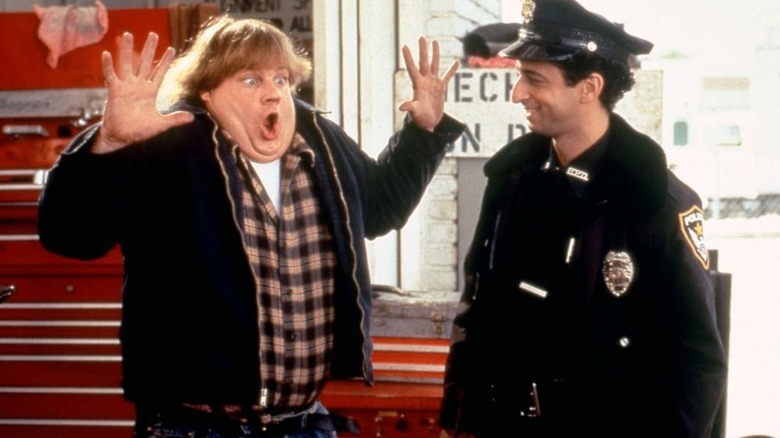
Favreau admitted on "Smartless" that he always enjoyed improv and acting, saying that it was a low-stress gig:
"I like that there was no pressure on me, so it was like school plays, and that was just a fun time for me. Improv was great, because when people went up on their lines, that was the most fun, like when you could be on stage and get out of that, but I never thought it was an option."
After the crash and the disillusionment with Bear Stearns, Favreau talked about his move to Chicago, describing the crowd that drew him there and how he made ends meet. He also recalled very sharply one magic night of going to see some improv at a famous Chicago comedy institution, and the game they played with him. Favreau was the one who gave the prompts, and the comedy troupe was to take it away. In his words:
"That's when I saw people doing improv in Chicago. I had a friend who was taking classes at iO and at Second City, and I was like, this is the best. I was in my 20s, I think I was 22 at the time. I knew how to bartend [...] I volunteered to be on stage, and the first thing I remember, they interviewed me about my day. It was the Improv game at iO called 'The Dream,' where they interview you about what happened that day, and then they improvise in front of you what your nightmare is going to be like that night, based on your responses."
Anyone who has been to a live improv show will likely be familiar with a similar game, but a notable "SNL" cast member was on stage with him that night.
The Power Of Improv
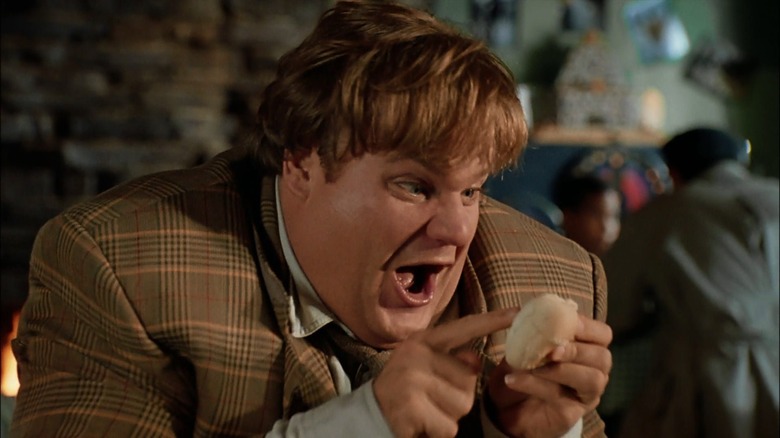
Yes, the man who took Favreau's role on stage was none other than Chris Farley. Not only did he have an early celebrity-to-be-to-celebrity-to-be encounter, but Favreau was astonished at how improv actually worked. They really do, he found, make stuff up on the fly. In Favreau's words:
"So they did that with me, and I was on stage doing an interview, getting some laughs, and then Chris Farley played me. So that was my first experience seeing improv, was Chris Farley playing me, and watching them really improvise. [...] When you see good improv, you think, 'Oh, is that just a shtick they have up their sleeve, right?' But I know they improvised it all, because it was all coming off of my interview, and I was completely flabbergasted."
It may have been his encounter with Farley that shaped Favreau's eventual skills as a director. He talked a little bit later in the interview about working with Vince Vaughn, his co-star in both the 1997 film "Swingers," which Favreau wrote and starred in, and the 2001 film "Made," which he wrote, starred in, and directed. Favreau admired Vaughn's ability to ramble and improvise for minutes at a time, completely on the fly. Indeed, Favreau admitted that Vaughn's ability to improvise was so sharp and fast, that, as a co-star, all he could do was stand aside and play the straight man.
His work on "Swingers" and "Made" laid a firm foundation for Favreau's career as a filmmaker. He eventually gained mainstream studio experience on films like "Elf" and "Zathura." He is now one of the premiere directors at Disney, having made "Iron Man," "The Lion King," and "The Mandalorian."
Farley, one might say, was the bearer of his fate.
Read this next: All 10 Chris Farley Movies, Ranked Worst To Best
The post Chris Farley Played Jon Favreau on the Improv Stage Before Either of Them Became Famous appeared first on /Film.
Antiviral @ 10: The Beginning of Brandon Cronenberg

It's been a decade since Brandon Cronenberg came into the scene, with Antiviral as his feature debut. That film was preceded by a couple of shorts, succeeded by various music videos, Possessor, and this year's Infinity Pool. Common themes reverberate through his oeuvre, linking him to his father's cinema. Like David, Brandon Cronenberg works within dimensions of horror, often considering transcendence through the body and the body transcended, altered, made a dream cum nightmare. Yet, despite similar interests, shared names, linked blood, father and son feel like unique auteurs, their connections superficial. One would expect the nepo baby to forever live in his patriarch's shadow, but maybe not…
Discord Says Cooperating in Probe of Classified Material Breach
Read more of this story at Slashdot.
More and More Americans Are Gaming the Deposit-Insurance System
Read more of this story at Slashdot.
Get a One-Year Sam's Club Membership for $10 Right Now

For Sam’s Club’s 4oth birthday, they’re offering deals for both tiers of their memberships for a limited time. You can get the basic the Club membership for $10 (usually $50) and the Plus membership for $60 (usually $110).
Anime Shows You Should Watch If You Loved Yasuke
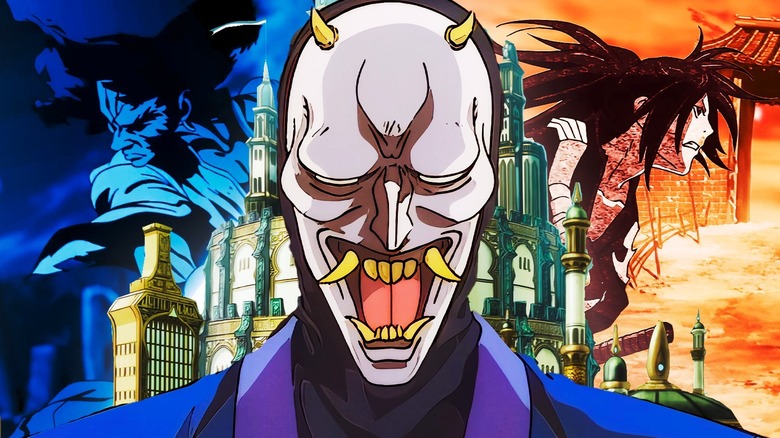
Released in 2021, "Yasuke" is an anime miniseries created by LeSean Thomas for Netflix. Based on a legendary figure from Japanese history, the titular Yasuke is an African man who comes to Japan with some Jesuit missionaries and eventually becomes a samurai in the service of Lord Oda Nobunaga. When Nobunaga and his forces are destroyed by another warlord, Yasuke flees and finds a quiet retirement as a boatman outside a small village. When he's asked to help a sick little girl get to a doctor, he soon finds himself called on to fight once again.
With only six episodes, it's entirely likely that "Yasuke" will leave you wanting more. Fortunately, there are lots of other anime series out there for you to watch, and quite a few of them have similar settings and themes. We've put together a list of anime you should check out once you've watched Yasuke, and most of them involve sword fights and Japanese history.
Cannon Busters
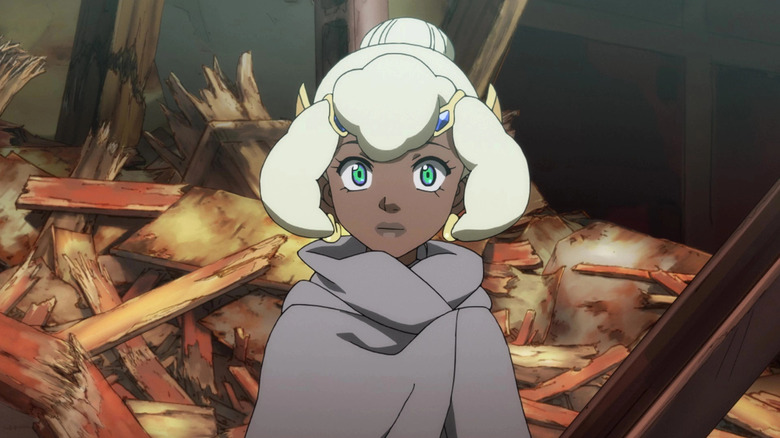
"Yasuke" isn't the only anime from creator LeSean Thomas to show up on Netflix, so if you're interested in his work, you should probably check out his first. "Cannon Busters" is about a robot girl named SAM who teams up with a criminal named Philly the Kid while looking for her best friend, Kelby, who happens to be the prince of their embattled kingdom. Nobody in "Cannon Busters" is quite what they seem at first. Philly is immortal due to an old deal with a devil, with a number appearing on his body for every would-be death. Meanwhile, SAM looks like an innocent young woman most of the time, but when one of her friends is in danger, she instantly converts to an intimidating "cannon buster" form.
"Cannon Busters" is LeSean Thomas's first real anime, although his previous adaptation of Aaron McGruder's "Boondocks" for Adult Swim certainly had anime influences. In "Cannon Busters," we begin to see the mix of Western and Japanese elements influencing his storytelling, whereas in "Yasuke," we see those elements fully come into harmony.
Afro Samurai
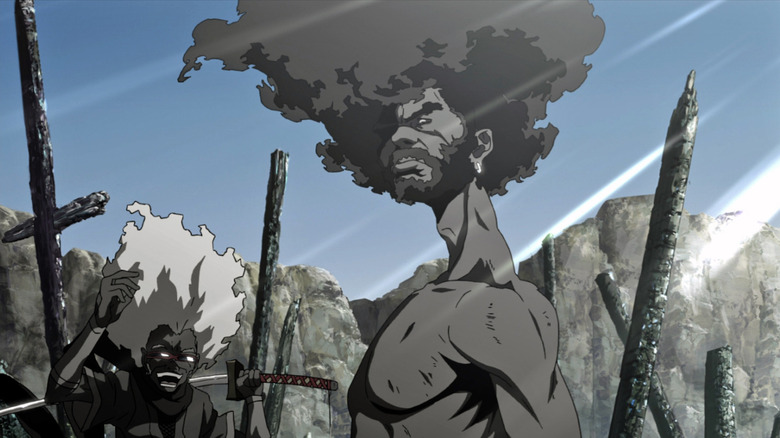
You probably don't need this article to tell you that if you're looking for another anime about a Black samurai, you should probably check out "Afro Samurai." But seriously, if you've never watched it, it's really good. Manga artist Takashi Okazaki was inspired by his love of hip-hop and soul music and decided to combine a Black protagonist and American storytelling elements with Japanese history and culture. The original legend of Yasuke is also said to be an inspiration for Afro Samurai, although that certainly wasn't Okazaki's focus. The manga was adapted into an anime miniseries in 2007, with a follow-up movie in 2009. Both feature the voice of Samuel L. Jackson and the music of the RZA.
Afro Samurai (yes, that's actually the character's name) lives in a futuristic feudal Japan that's even less interested in historical accuracy than the Mech-infused world of "Yasuke." Afro's father wore the Number One Headband, which grants power to the world's greatest warrior. When a gunslinger named Justice kills him and takes the headband, Afro devotes his life to becoming a great warrior so that he can one day exact his revenge and take the Number One Headband. Of course, he learns that vengeance is a complicated and messy path, but there are lots of awesome sword fights along the way.
Samurai Champloo

If you're looking for samurai stories infused with a modern hip-hop sensibility, you can't go wrong with "Samurai Champloo," which first aired in 2004. Acclaimed creator Shinichirō Watanabe's follow-up to his huge hit "Cowboy Bebop," this series replaces jazzy space battles with breakbeat sword fights to great effect. "Samurai Champloo" features two diametrically opposed fighters: the chaotic outlaw Mugen and the taciturn samurai Jin. Although they are enemies on sight, they reluctantly team up to help a young woman named Fuu on a mission to find a mysterious samurai from her past.
Although the series is set in a recognizable version of the Edo Period in Japanese history, it brings in modern music and sensibilities. Many of the episodes focus on figures who are outsiders in Edo-era Japan because of their nationality, race, or sexuality. In its way, the series becomes something of a statement about how diversity is not new but has been an element of many societies all along. Most importantly, however, even when it has things to say, "Samurai Champloo" never forgets to be a fun and engaging samurai adventure anime.
Brave 10
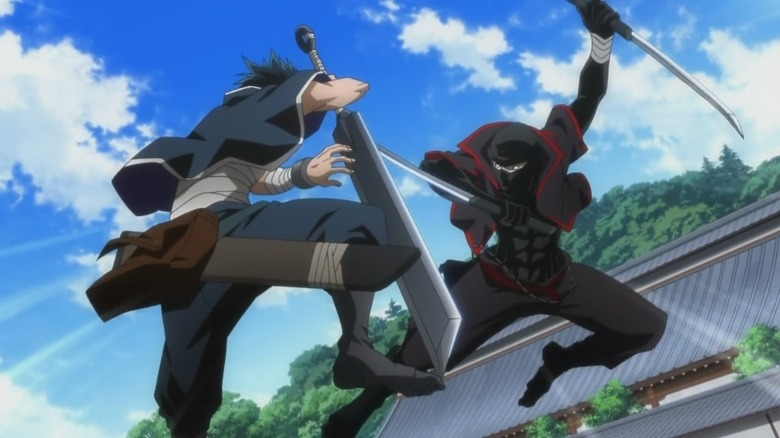
The 2012 series "Brave 10" takes place in the Sengoku period of Japanese history and retells the legend of the Sanada 10 Braves, a group of 10 ninjas gathered by the warlord Yukimura Sanada. The central character is Saizō Kirigakure, a ninja so skilled he's rumored to have never let an opponent touch so much as his hair. Saizō has killed many people and no longer seems to have much feeling about that (or anything in general) until he meets Isanami, a priestess he saves from a kidnapping attempt in the woods. They travel together to Yokimura's home, where Isanami seeks refuge, and Saizō joins the team he's gathering.
If "Brave 10" were a simple surface-level historical adventure, it would most likely be worth a watch. However, it has a bit more going on than just that. Each of the 10 Braves corresponds to an element, with Saizō representing light, something he has a hard time accepting about himself since he's caused so much death. Isanami, on the other hand, represents darkness, and when his power is unleashed, things become really interesting (and unfortunate) for all concerned.
Blade Of The Immortal
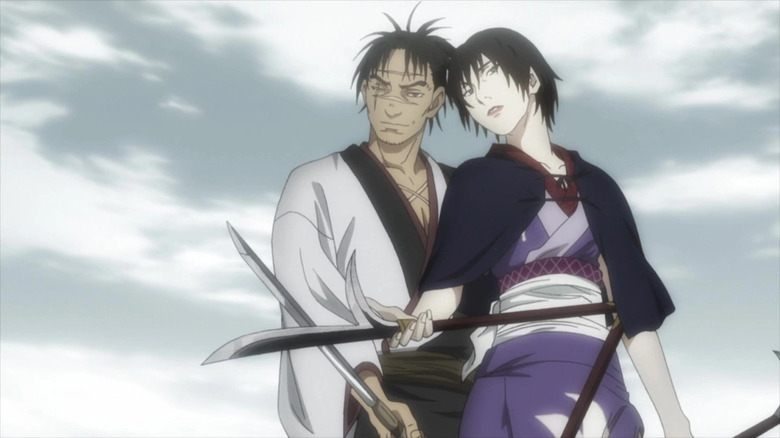
"Blade of the Immortal" is another classic of samurai-focused anime. Originally a manga that began in the 1990s, the first anime version came out in 2008. There was a new anime in 2019, and both are worth a look if this is the sort of thing you're into, but we're focusing on the newer version. The immortal of the title is a ronin named Manji, who is unable to die because of some sacred bloodworms he got from a weird nun named Yaobikuni. It's clear at the beginning of the story that he's not fond of his immortality. For one thing, he's pretty sure it makes him a worse swordsman since he doesn't have to put in as much effort, and it gives him lots of time to dwell on the 100 good samurai he slew at the behest of his former master.
Manji makes a deal with Yaobikuni that she'll remove the bloodworms and allow him to die if he kills 1,000 bad men to make up for the 100 good men he killed. Meanwhile, a young woman named Rin Asano is looking for revenge on the warlord who killed her family. She reminds Manji of his late sister, so he's inclined to protect her, and of course, there are plenty of evil men to be slain along the way.
Hyouge Mono
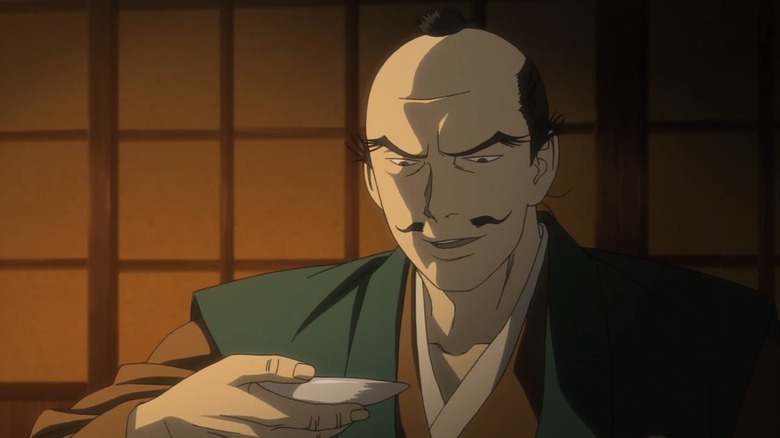
Released in 2011, "Hyouge Mono" is based on the true story of a Sengoku-era warlord named Furuta Oribe. While the realm is torn apart by war and upheaval, Furuta becomes obsessed with the Japanese tradition of the tea ceremony. He's an aesthete by nature, taken with the simple beauty of things like tea, pottery, and architecture. In a time of constant war, his perspective is difficult for many to understand. Ultimately, Furuta Oribe becomes a legendary master of the tea ceremony. The anime shows the value of his perspective as well as the importance of aesthetic beauty and community-fostering traditions.
"Hyouge Mono" is an unusual story and an entertaining one. It also has a lot of perspectives to offer viewers, not just on Japanese history and traditions but on the value of the arts in the face of violence and conflict. That's certainly a theme with resonance for today's world.
Samurai 7
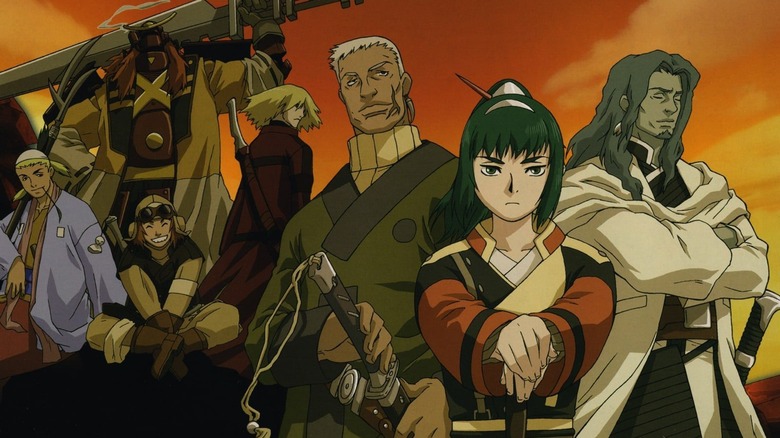
"Samurai 7" is an anime adaptation of the classic Akira Kurosawa film "Seven Samurai." It was released in 2004, 50 years after the original. Although it takes many departures from Kurosawa's version, starting with being set in the future, the seven warriors at its center have the same names and many of the same characteristics as their counterparts in that historical epic.
The wicked bandits that threaten a poor village in this version are cyborgs, making them that much more intimidating. A village priestess named Kirara is given the task of recruiting hungry samurai (since the town can only afford to pay them in rice), and the recruitment process is given a lot more space in the story, considering this is a 26-episode series as opposed to a movie. In addition to the grizzled leader Kanbei and the young romantic Katsushiro, the samurai include Kikuchiyo, an enormous armored cyborg with a truly huge sword. Perhaps inevitably, Katsushiro falls in love with Kirara, but Kirara falls for Kanbei, which inevitably leads to drama. And then, of course, they have to put all that drama aside to defend the village from evil cyborgs.
Shigurui: Death Frenzy
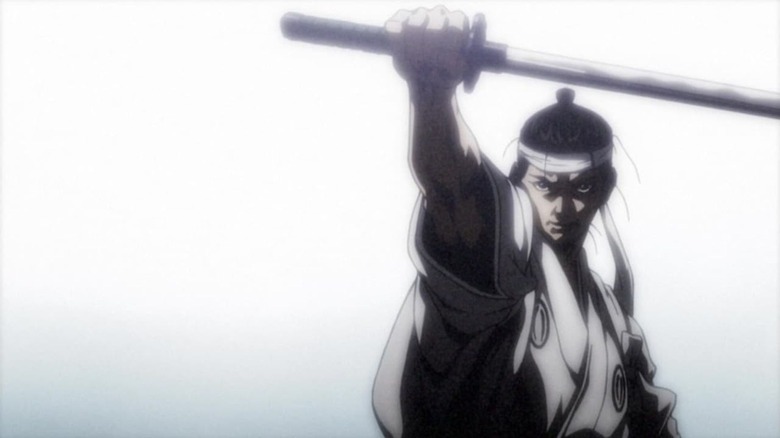
"Shigurui: Death Frenzy" came out in 2007, and the whole series revolves around one unusual fight. It's 1629, and the lord Tokugawa Tadanaga is holding a tournament in which the competitors will fight with real swords rather than the wooden training swords usually used for such activities. To the surprise of all in attendance, the first match of the tournament is between a one-armed swordsman named Fujiki Gennosuke and a blind Samurai named Irako Seigen. The series then goes on to tell the intertwined stories of these two men and how they came to this moment of inevitable conflict.
It turns out that Fujiki and Irako were both students of Kogan Iwamoto, a cruel sensei who runs his own school. Irako was once the heir to the school and engaged to marry Kogan's daughter, Mie. However, he also became involved with Kogan's concubine, Lady Iku, which led to his blinding and banishment. The less ambitious Fujiki then becomes Kogan's heir, despite losing his arm in an initial confrontation with Irako.
"Shigurui" is unrelentingly dark and grim in its tone, so it may not be for every viewer. The women characters are treated especially terribly, with depictions of sexual assault and extreme domestic violence. If you have a strong stomach, however, this is an entertaining and unflinching depiction of a dark time in Japanese history.
If you or anyone you know has been a victim of sexual assault, help is available. Visit the Rape, Abuse & Incest National Network website or contact RAINN's National Helpline at 1-800-656-HOPE (4673).
Basilisk: The Kouga Ninja Scrolls
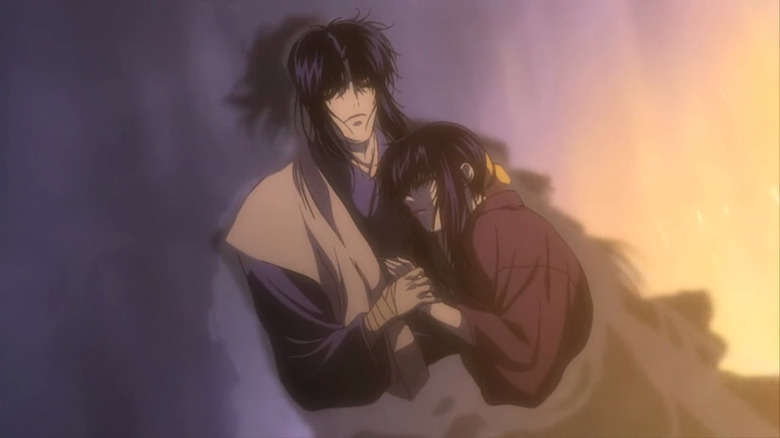
"Basilisk: The Kouga Ninja Scrolls" was released in 2005 and takes place in the era when Japan was first united by one ruler, the Shogun Tokugawa Ieyasu. When Ieyasu first seizes power, the legendary ninja Hattori Hanzo ends a centuries-long feud between two clans, the Iga of Tsubagakure and the Kouga of Manjidani, by conscripting both to serve the new shogun. A few years later, in 1614, that peace ends when the two clans are ordered to each send their 10 best ninjas to fight to the death. It seems there's disagreement about which of Ieyasu's grandsons should eventually inherit the shogunate, and it's already threatening to tear the young nation apart. Each ninja clan will fight for one of the heirs, determining once and for all who will eventually rule Japan.
The ninja clans never asked for this, especially after they'd spent years putting their feud behind them. Gennosuke Kouga, leader of the Kouga clan, is a young man who strongly believes in looking to the future and not holding grudges. As proof of his principles (and because he's in love, of course), he's even engaged to Oboro, the heir to the Iga clan. Unfortunately, what the shogun says goes, and the two are bound to be mortal enemies.
Gintama
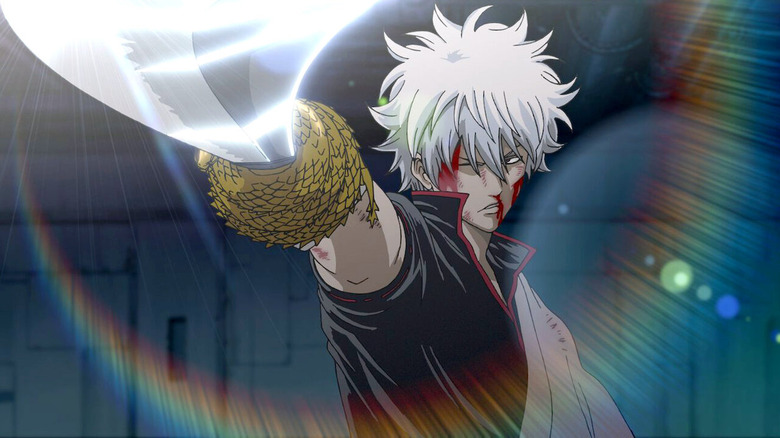
No anime mixes samurai and science fiction more enthusiastically than "Gintama" from 2006, a series that takes place in an alternate version of feudal Japan occupied by invading aliens. Although the samurai of this world defended Earth against the invaders, the shogun surrendered to the aliens and allowed their occupation. Twenty years later, technology has vastly increased, but publicly carrying swords is illegal, and samurai are persona non grata. That leaves Gintoki Sakata, the series' protagonist, to take up a life of odd jobs to make ends meet.
Despite his unglamorous new career, Gintoki employs Shinpachi Shimura, a teenage boy who wants to learn the way of the samurai, and Kagura, a friendly alien girl. Together, the three have adventures involving aliens and samurai as they struggle against the strange world they live in and Gintoki's shady past.
"Gintama" is extremely comedic in tone, with a lot of fourth-wall-breaking humor that pokes fun at manga and anime tropes. It might even be the silliest thing on this list, but after witnessing the violence and tragedy of shows like "Shigurui" and "Basilisk," something silly might be just what you need.
Dororo
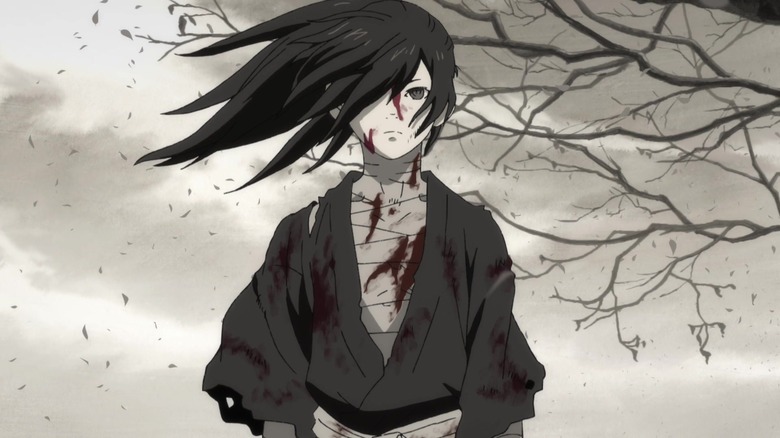
The original "Dororo" anime was created by "Astro Boy" innovator Osamu Tezuka in 1968, but that's not the one we're here to talk about today. In 2019, Tezuka's original manga was adapted into a new series that brings modern sensibilities to the already unusual story. It tells of Hyakkimaru, a young ronin whose limbs and several organs were sacrificed to 12 demons by his father when he was a newborn. As an adult, Hyakkimaru is equipped with prosthetics and the ability to see (and, therefore, fight) demons hiding on Earth. On the road, he meets young Dororo, who becomes his traveling companion, as he looks to retrieve his lost body parts from the demons. Dororo not only helps him with day-to-day stuff because of his disability but also becomes his emotional tether to humanity, as he is tempted to give in to the violence that has defined his life. As you can tell from the premise, this one is extremely dark, but it's also emotionally rewarding.
Eventually, Hyakkimaru must confront his evil father and fight his younger brother, who has become his father's heir. It turns out Dororo has a complicated family history, as well, and needs Hyakkimaru's help at least as much as he needs hers. This dark fantasy goes to some pretty unique places with the "wandering ronin" premise, and the 2019 version is well worth a look.
House Of Five Leaves
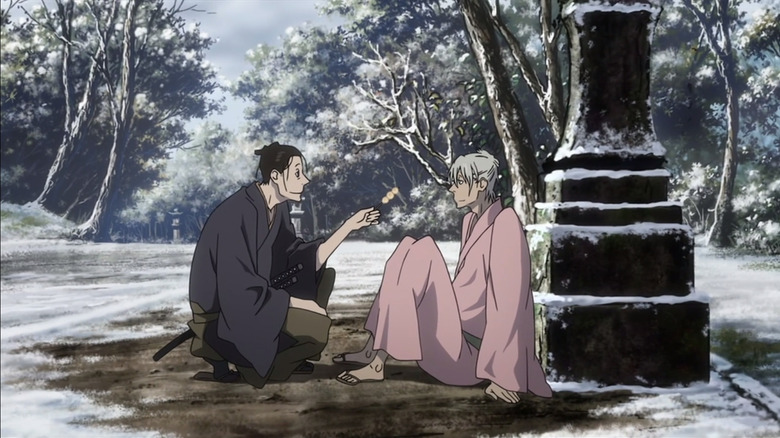
Another Edo period story, 2010's "House of Five Leaves" follows Masanosuke Akitsu, a down-on-his-luck samurai. Although he's a good swordsman, Masanosuke (or Masa for short) is a naturally timid man who gets uncomfortable around crowds. This leads to his shogun releasing him. Disgraced and unable to support his family, Masa moves alone to Edo (Japan's capital city, later renamed Tokyo). Looking for work as a bodyguard, he takes a job with a man named Yaichi, who turns out to be the leader of a criminal gang called the Five Leaves. Masa is initially reluctant to work with the Five Leaves, being more than a little uncomfortable using his skills for crime. However, he can't stop thinking about Yaichi's carefree attitude and gets increasingly drawn into the world of the Five Leaves.
Throughout the series, Masa tries to learn about Yaichi, whose origin story is finally told in the final episode. Yaichi was adopted by a prominent family but was kidnapped on his adoptive mother's instructions after she got pregnant with another son. He never goes back home, living the life of an outlaw from then on. Like Masa, he's a man who lost his family and is living the only life left to him, even if he seems to be having a great time.
Rurouni Kenshin

A classic of '90s anime, "Rurouni Kenshin" stands the test of time and is worth revisiting if you're in the mood for samurai stories (and if you've made it all the way through this list, you probably are). The title character is Himura Kenshin, a legendary assassin who has renounced his former ways and become a wandering swordsman who carries a "reverse blade sword," a katana with a cutting edge on the inner-curved side of the blade that makes it nearly impossible to kill with. As the series begins, Kenshin wanders into Tokyo, where he meets Kamiya Kaoru, a woman who owns a dojo. He takes up residence at the dojo, offering protection and help to those around him. Meanwhile, enemies from his violent past reemerge to cause trouble.
If you're looking for good anime about samurai and other sword-wielding Japanese historical figures, there's no shortage. This list probably could be twice as long, but we did our best to gather for you the cream of the crop from Champloo to Kenshin and focus on those that bring a modern sensibility to the table in a similar manner as "Yasuke."
Read this next: 14 Anime Series Like Chainsaw Man You Need To See
The post Anime shows you should watch if you loved Yasuke appeared first on /Film.
Leader of Online Group Where Secret Documents Leaked Is Air National Guardsman
Read more of this story at Slashdot.




